|
Archived Latest News - 2020 Updated 26th December 2020
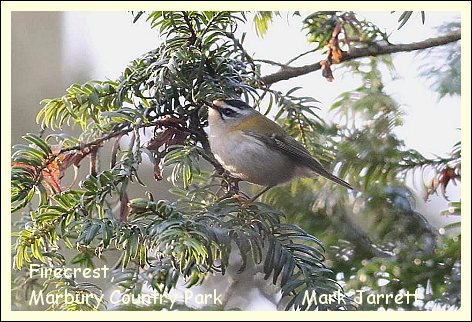 found. found........"I went over to Marbury with high hopes and had an excellent visit. The ringtail hen harrier that had been there on the Sunday (and at Neumann's the day before) was too much of a long shot so my aim was to see the diminutive rarity in Big Wood. En route I met up with Geoff and Sheila and just afterwards at the hide three birders came past who had just been watching the Firecrest! Following their directions and trying to ignore the brambles scratching my legs I joined another hopeful birder scanning the two big yew trees at the back. After half-an-hour he had to give up and go back to Crewe and I was considering leaving myself when birder-with-bike arrived from the other direction (a much easier route) and within minutes we were watching the little gem as it came out into sunlight near the top. What a lovely bird! Also seen the pair of Wood Ducks, pair of Goosanders, drake Pintail and when there was a disturbance at the far side of the mere 200 Curlews and 500 Lapwings (rough counts) went up. Great....." My thanks to Mark Jarrett for giving me permission to use the image of the Marbury bird (he refers to it as a record shot - some record shot Mark!) Peter Dawson has been spending more time at Booths Mere recently, where he too had Goosanders......"The Black Redstart was still about yesterday when I was there. Another birder I met had seen it and I got a glimpse of what I think was it. There was also a report of it on Birdguides later in the day when it was back on the office roof. There are also a few Goosander on the mere, a Pink-foot amongst all the Greylags and 10 Egyptian Geese and a pair of ravens over. I'm going over there quite regularly now but haven't always seen the BR. Preferable to Tatton Park where there are so many people and dogs running around all over the place! ......." Understandably in the current circumstances Tatton is getting a little crowded at times but it doesn't seem to affect the wildlife, on Thursday (24th), on his daily walk, Roger Barnes counted 150 Greylag Geese on Melchette Mere plus an interesting duck which, from his description, was, perhaps, a female Common Scoter. At this, the other end of the size scale from the Firecrest, Pinkfeet have been passing over our area. Last Sunday (20th), whilst doing some essential maintenance in the garden, a flock I estimated at 400 to 500 passed over, heading due south and on Christmas Eve Len Mason had 400 flying west. There's no finer sight and sound, natural or man-made than these flocks of Pink-footed Geese. The temperature on my weather station dropped to -2.5 ° C in the early hours of Christmas day and there followed a cold but sunny morning. Members took full advantage - even the Hon.Sec. and Mrs. Brookes!".........Years ago Jean and I had an Xmas walk down Sudlow Lane; well, we decided to go this morning being glorious sunshine, no wind and the temperature just above freezing. We hoped to see a Brambling no luck. The highlight of our walk must have been GS Woodpecker drumming shows we are on upwards turn towards spring. Other birds below. Blue, Great, L T Tit, Nuthatch, several Redwings flying and scuffling about in the leaves. 1 Fieldfare, Tree creeper, Jay, Blackbird, Song Thrush, Mistle Thrush, Carrion Crow, Rook, Robin, House Sparrow, Chaffinch, Magpie, Kestrel, Buzzard, Dunnock, Black-headed Gull". Geoff and Sheila Blamire went over to Moore........."Our Xmas morning walk - set off at -3C with some sunshine and little wind. Fortunately the mud and enormous puddles were frozen to make it easier going. Moore NR: started with Wigeon, Teal, Gadwall, Mallard, etc. 2 brief visits of a Willow Tits at the feeders, plus Coal, Blue and great Tits, Nuthatches, Chaffinches, etc. Upper Moss Side: small flock of Reed Buntings. Canal towpath: flushed a Woodcock! Mersey River towards Wigg Island: usual gulls, etc, plus 21 Curlews and 100s Lapwings (at low tide). Back to Moore NR: superb male Bullfinch. A Good morning all round.............." over in Marton Steve and Gil Barber also took advantage of the good weather......." We had c90 minutes out along a local lane. Ponds were frozen except one with a little open water which held a few Mallard and Teal. It was good to see that the field flood which provided lockdown LRPs in spring was back though iced over. Highlights were 7 Buzzards on the Lapwing field (but no Lapwings) and a Raven flushed from an item of food in another field. Anything smaller than a thrush was very thin on the ground! " Thanks for your reports folks and to everyone who sent in their sightings over the past year. This will be the last of 2020's updates. It's no use me trying to summarise the events since March, they'll be talked about and analysed by all and sundry for decades to come. Long after we're all gone. Lets just hope that 2021 proves to be a little less stressful for one and all. We're now passed the shortest day, Derek mentioned a Great Spotted Woodpecker drumming on Christmas day and the Dunnocks are singing in the garden - things can only get better!! 16/12/2020...... The Black Redstart is still around
Highlights at Tatton included 4 Little Grebe and 12 Snipe with good numbers of Mallard overall (124)............ You can access the latest counts by clicking here. The following day Bob Groom also went in search of the Redstart, he didn't find it but he did have what must be a record count of Greylags!........ As I couldn't go into Tatton I used my hour off to check Booths Hall in case the BR was still around. I didn't see it, perhaps moved on in the week, and only a few birders around also having no luck, so I concentrated on Booths mere. As Peter mentioned a huge amount of wildfowl, more species and bigger numbers than I've been having at Tabley recently and more than I can remember being there when I used to check it way b back. Must definitely keep monitoring it. A few Redwings around also. Surprisingly all the Greylags went up (140+) at one point (and all the ducks!) when a Buzzard went over and their calls echoed off the buildings. True stereo effect! I've been in Tatton a number of times since the last update, it's busy at weekends of course, but in mid-week you can always find a quiet spot, especially up past the Old Hall towards the Mill Pool. New birds this week were a couple of Siskins in the alders next to the Melchett car park. Geoff and Sheila Blamire have recorded Siskins in their Mere garden, but no Lesser Redpolls yet this season. So we beat them to it in Bucklow Avenue where I saw two on the sunflower hearts last week but they flew off when I went inside to get the camera and haven't re-appeared! The two Stonechats have been frequenting the big juncus reed beds at the north end of the park as well as the reeds along the western edge of Tatton Mere, this is where I found them last Friday(11th) where they were joined by a third party - the little weasel shown above (I also obtained my best photo yet of the female Stonechat but I've been told the world doesn't need any more Stonechat pictures, so it will have to remain on file!) Today I walked as far as the conifer plantation hoping to perhaps locate a Firecrest (they've been recorded here in the past and there's one currently in the Big Wood at Marbury Park) Plenty of Goldcrests, seen and heard but they were high up and against the light, so no luck. A little further up, just beyond Higmere Plantation and you're on Knutsford Moor where Hugh Pulsford and the South Manchester Ringing Group do much of their valuable work although, because of the virus, activity has been restricted this year. We have been a bit restricted this year for obvious reasons but also the contractors responsible for "attempting" to clear the Himalayan Balsam encroaching along the waterways into the Moor. Their technique was originally to simply clear the entire area , cutting all the phragmites in one go, yes all 11 hectares!! but I managed to step in and stop that reminding them and Tatton Estates that the breeding birds need last years reed stems to build their nests on. Amazing what environmental consultancies don't know. I also had to remind them that as a SSSI on botanical grounds, the ground flora was a balance of the entire area and below the phragmites were "interesting sedges and bog plants". They were also too late in the season, so touching any plant led to an explosion of seeds etc. I gave them contacts at Woolston Eyes and RSPB folks who are savvy with HB clearance techniques and they have upped their game to a degree, but it is a one man band with a couple of helpers, which as we all know is useless against an invading plant like that. So they have been clear felling in quarters of the bed earlier before the plants set seed, (although this has reduced the breeding number of Reed warblers using the area). They don't have the resource of the weed touch killing techniques or the ability to pull the plants earlier in the season which is very manpower intensive but highly effective. I have had to juggle net lanes and catching areas over the last two years, although it is still a dangerous place to set foot in. The contractor tells me his workers have disappeared up to their arm pits on several occasions just stepping off a fox path not 20 yards from the road, and needed rope and tackle to get out!. there are no natural paths or walkways into the bed. (I of course only send my trainees in!) I've added a couple of sound files to the website this week. The first is from the "Today" programme and is about nocturnal migration [click here] The second is a tribute to Eric Hardy, first broadcast on Radio Merseyside shortly after his death in 1992. [click here]. It's quite long but very entertaining as the great man rails against authority! Encouraging news from founder member John Somerville this week. His oft-postponed heart operation finally went ahead on Monday, he's back on the ward and anticipates going home tomorrow (Thursday 17th). It's been a frustrating time for JS but hopefully in a couple of months time, like the rest of us, he'll be out and about again visiting our favourite biding spots - Tatton, Woolston, Burton Mere and, John's favourite - Lunt Meadows. 06/12/2020...... Black Redstart! To say that Peter Dawson seems to have had a pretty good morning's birding yesterday is perhaps a bit of an understatement! After some nice birds on the rarely visited Booths Mere, he rounded things off with nothing less than a Black Redstart on the 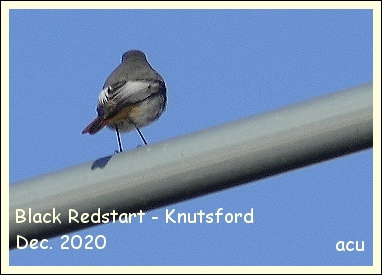 roof of one of the buildings that make up the small Booths Park business centre. ........."Just a quick report to say that I found a black redstart this morning on top of no. 3 building at Booths Park at around 11.40am. I've posted it on Birdguides but thought I would let you know so that you can pass it on to anyone local that may be interested. roof of one of the buildings that make up the small Booths Park business centre. ........."Just a quick report to say that I found a black redstart this morning on top of no. 3 building at Booths Park at around 11.40am. I've posted it on Birdguides but thought I would let you know so that you can pass it on to anyone local that may be interested.There was also a pair of mandarin, an Egyptian goose and a single male teal on Booths mere viewable from the road at Booths Park........ " Steve Barber received the news via Rare Bird Alert and sent out an email to local birders and it was one of those, Hon. sec. Derek Pike, who was on his computer at the time and rang me with the news, enabling me to drive to Booths Park in double quick time! Luckily the bird was still in-situ and I spent an hour there, managing to get a few record shots; not very clear but enough for County Recorder and ringer, Hugh Pulsford, to identify it as probably an adult male. Thanks Hugh, thanks and well done Peter - that's a heck of a record for your lockdown list!! 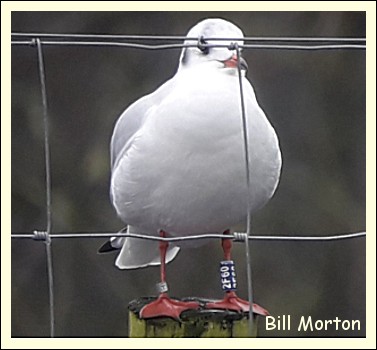 Frodsham birder Bill Morton has obtained details of the five ringed Black-headed Gulls he observed recently in Tatton Park. [click here for Bill's report] Frodsham birder Bill Morton has obtained details of the five ringed Black-headed Gulls he observed recently in Tatton Park. [click here for Bill's report]The data meant little to me, so again I had to prevail on the good offices of Hugh who was able to de-cipher the hieroglyphics! All the birds were ringed locally, four in Knutsford and one at Redesmere, three were ringed in 2013, the other two this winter. All had been sighted at other locations, mainly in the UK and especially at Tatton during the Winter months. The bird in Bill's photo though had been recorded further afield - after being ringed in Knutsford in January 2013 it was seen three months in later in the Netherlands where it was again present in March the following year but it was back in the UK in April 2014, at Muswell Hill, Greater London. It returned to Tatton in the Winter of 2016, then not sighted again until January this year in the park before a March record from Kaunas, Lithuania. It may have been nesting there or stopping off on its way further north. Only a week or so now before the shortest day and we can begin to look forward to a Spring and Summer that will be so different than the ones we had to cope with this year. Some species are already anticipating the coming warmer weather, Derek told me a couple of weeks ago that Rooks are gathering at the rookery along Northwich road, I've seen them too, driving from Mobberley to Ashley at their traditional site next to the road, just passed Sugarbrook Farm. In Tatton Maria Freel, who's lucky enough to live in the park, reports much activity from the resident Tawny Owls as they too prepare for next year. If you're ever involved in survey work it's useful to remember that this is the best time of the year to map Tawny Owl breeding territories. Geoff and Sheila Blamire continue with their punishing exercise regime, ready for the return to "normality" .........."We did our 'usual' c9km around Plumley and Holford area this morning (29/11). Even though it was foggy it was a good walk with some good birds. Starting off with Kestrel and Buzzard (first of 3), then stopped to watch some confiding Goldfinches feeding on small seeds and a pair of Dunnocks displaying with a lot of wing flicking whilst uttering piercing calls. Then we encountered mud, and more mud! But we knew that on the other side of the railway line it was tracks and lanes, so we 'ploughed' on. Disappointing no sign of the pair of Stonechats, but in a small field there were single Shelducks and Lapwings and 11 Curlews. Really love their calls, more haunting with the foggy conditions. Around the farms we came across 100s of Starlings (perhaps 1000?), 200+ Lapwings, several Pied Wagtails - the latter really like to hang around the farm buildings. Strangely, in a small field, was a single Great-blacked Gull - looked out of place. The only thrushes we came across were Mistle Thrushes and Blackbirds, no winter thrushes at all. 3 Curlews flew overhead as we were returning to our car. A great morning. We started doing our daily walks on March 23rd when the Lockdown #1 started. Of course , initially, you only allowed out for 1 hour for exercise and only from home. But now we average 9km per day. Now we've covered 1286 miles (2057km), and are just the other side (south) of Rome!" Late News Sunday evening, 6th December, a number of people have been along to Booths Park today hoping to see the Black Redstart but as far as I know only Jean Brookes and Bob Groom were successful. 28/11/2020...... A busy time in the park
Geoff and Sheila Blamire have included Tatton on some of their daily walks and on the 19th bumped into the Stonchats again ......."We did our usual 9.8km starting at Dog Wood, then along Tatton Mere and came across pair of Stonechats, just before the bench (where we had them last visit). Wildfowl included least 7 Goldeneyes and lot of Pochards (didn't count them). Past the toilets, through the wood, across the wooden bridge and to the Mill Pond where it's getting very difficult to find a route through to the Deer Park fence - because the tussocks are so waterlogged with numerous little rivers. Onto Millennium Wood where 2 Ravens were circling overhead. Then negotiated herds of Fallow Deer without disturbing them - rather pointless because 3 separate couples walked right through them. I get so annoyed with them. Onto Melchett Mere (so many Canada Geese!) and then spied Bob Groom watching the pair of Stonechats at the north end of Tatton Mere (obviously had flew back from the other side of the mere). After a quick catch-up we continued down the mere accompanied by the Stonechats. But it was getting busier and busier and the birds kept being disturbed. Continued to the Knutsford Gate and back to the layby." Yesterday, whilst following a similar route, they met Frodsham birder Bill Morton who had photographed the five ringed Black-headed Gulls that were reported by Alan Gillespie earlier in the week, perched on the deer fence, at the southern end of Tatton Mere. The images were good enough for the inscriptions to be read and, when he receives information about the birds, he'll pass it onto Sheila. I spent a couple of hours in the park yesterday afternoon in the agreeable company of Bob Groom; nothing to write home about - Sparrowhawk, Buzzard, Meadow Pipits, 4 Skylarks over, Dabchick, Raven, c.30 Redwings. 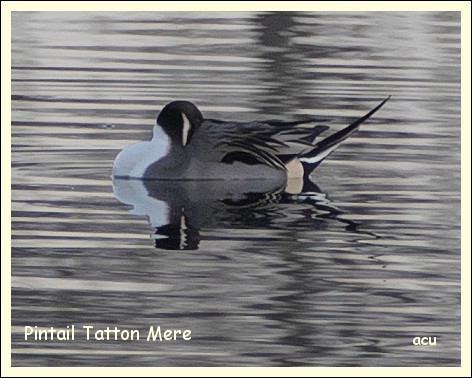 A fine drake Pintail floated gracefully on the main mere amongst the Tufted Ducks, Pochard and 2 ♂ and 6 ♀ Goldeneye. Melchett was covered with Geese, a handful of Greylags amongst a huge flock of Canada's, we estimated at least 1,000! A fine drake Pintail floated gracefully on the main mere amongst the Tufted Ducks, Pochard and 2 ♂ and 6 ♀ Goldeneye. Melchett was covered with Geese, a handful of Greylags amongst a huge flock of Canada's, we estimated at least 1,000!Darren Morris has sent me a copy of the latest Tatton Park Newsletter (Winter 2020-21) produced by the park rangers [click here to download it] Thanks Darren. I'm lead to believe that Natural England have decreed that the volunteer wardens should now be referred to only as volunteers! Anyway, whatever, they're a hard-working bunch and volunteer Phil Dell has updated me as to the latest position regarding access. The permissive paths will probably stay open? (I wait for more information later this week). Think the government wants us to have a lot of exercise in order that we don't all go loopy, so going for a brisk walk and washing all the dog muck off our boots after is very good for mental health. If the permissive paths do stay open then I would assume the NE car park at Rostherne will too, but I'll wait to see. The Observatory, Dave's Hide and the Bittern Hide will all be closed for the length of the lock down and possibly longer. [ I was working towards opening sometime soon with restrictions, but only when I have all the materials I need from DEFRA in order to open them in a Covid safe way,.....which of course will now be delayed]. On the plus side if you can't sit in a hide then you will have to keep walking or standing up and therefore that's even more exercise, plus the bonus that you won't get claust-hide-rophobia. Thanks Phil and keep up the good work! As Phil noted the permissive paths are still open and our dynamic duo took advantage last Sunday (22nd)....... " If you go to Rostherne be aware of a determined Mistle Thrush to keep a holly tree, with a very good crop of berries, to himself! Obviously he saw us as a threat!! It's on the little lane leading to the church, on the right just before the cctv (remember to smile!). A little further down, just before the cricket field, a Song Thrush was singing - heard it there many times in spring/summer. Still a good number of winter thrushes (more Fieldfares) on the autumn-sown cereal fields and a distant c50 finches - too far to identify but probably Linnets (definitely not Goldfinches)." Bob also visited the Rostherne on the same day ....... "There were at least 20 cars parked along the road to Rostherne village from opposite the park entrance (I don't remember seeing this before) and the Natural England car park was full. People seemed to be everywhere.. The reliable female Kestrel was on the wires as usual with a Mistle Thrush sat almost beside it, well aware it was too big to be prey. 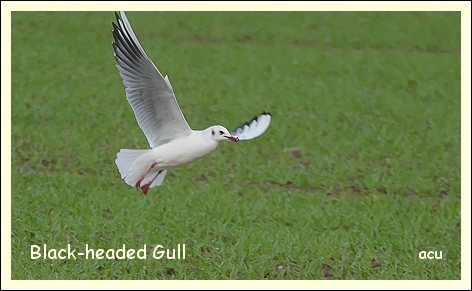 A second bird later joined it. Half-a-dozen Fieldfares passed by but the few small birds were too distant to id. The Collared Dove colony seemed to be well into double figures. Female Great Spotted Woodpecker but no sign of the guardian of the berries until 2 Redwings appeared. Suddenly it was there, calling loudly, and they quickly went on their way. Drake Goosander and Wigeon on the mere but not a lot else I could see. No buzzard". A second bird later joined it. Half-a-dozen Fieldfares passed by but the few small birds were too distant to id. The Collared Dove colony seemed to be well into double figures. Female Great Spotted Woodpecker but no sign of the guardian of the berries until 2 Redwings appeared. Suddenly it was there, calling loudly, and they quickly went on their way. Drake Goosander and Wigeon on the mere but not a lot else I could see. No buzzard".On Monday (23rd) I walked over to the Mobberley field pool, to the east of Gleavehouse farm, where we'd been so pleasantly surprised and entertained during the first lockdown by the variety of species to be found there. Yellow Wagtails, Little Ringed Plovers, Yellowhammers, Shelducks, Oystercatchers, Swallows, House Martins and even a passing Ring Ouzel. A little bit quieter at this time of the year though, in fact the water was completely deserted and the track passing to side of the pool a foot deep in glutinous, muddy water. Wendy Stratford and Jane Davies had both been down there, so I had been warned! Really the only thing of interest was a loose flock of Black-headed Gulls searching for food as they silently quartered the big fields of winter wheat that have now germinated and are growing well. Last year's wheat crop was apparently 38% lower than in 2019. Hopefully, with the promising covid vaccines just around the corner, in about 12 weeks time we'll be able to get down there again, this time as a group, and welcome the return of our Summer visitors. 18/11/2020...... Out and About with the KOS Members have been out and about over the past few days and I've received some excellent reports of their activities (which makes my life a lot easier!) Let's start with Maria Freel's trip up to the wide open spaces of Shining Tor, above Macclesfield. Hi Tony, Not sure if this is a bit far away, but it is still technically Cheshire I guess. Went for a walk on Shining Tor last week and (among many MANY red grouse) I came across an incredibly tame snow bunting. 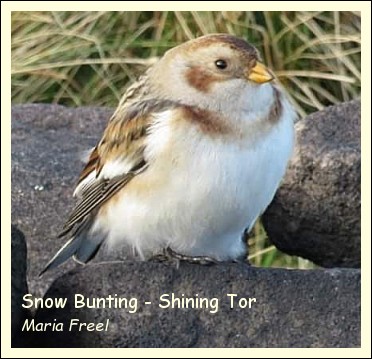 It was on its own (which is unusual in itself), but it was so unfazed by us that my partner nearly stepped on it when he first saw it! We had no camera with us, so just blurry phone photographs were had. It was on its own (which is unusual in itself), but it was so unfazed by us that my partner nearly stepped on it when he first saw it! We had no camera with us, so just blurry phone photographs were had.However, I enjoyed the quiet walk so much, I went back on the Friday, armed with my camera. To my delight it was still there! This time it was equally willing to pose, so I got a few good shots and decided it was most likely a male in its first winter. Anyway, I thought I would share the shots and the story with the group. Many thanks Maria, that's an excellent find! I know you've checked with Sheila Blamire and she's confirmed that Shining Tor is in Cheshire and, away from the coast, a county rarity!! The previous day (12/11) Bob Groom had taken himself off to Neumman's Flash and Budworth Mere, he had a very productive visit. Neumann's area was rewarding. c.25 Meadow Pipits, 5 Reed Buntings, several Redpolls, a Cetti's Warbler seen at pointblank range (presumably a juvenile as it hadn't properly mastered the song/call) during a brief lull in the human traffic. A lady came up just in time to hear it and was chuffed when I told her what it was as she had recently heard the song/call on Tweet of the Day.. 8 then 14 Snipe flew over. 4 Buzzards. On the Flash - 5 Shelducks, Teal, 3 Shovelers, 3 Gadwall, 28 Greylags, 2 Common Gulls attracted my attention, one doing a strange dance on the water, presumably trying to get at something edible while the other watched it, hoping to cash in, perhaps. 102 Lapwings in the air. Heron.. 3 Jays. Cormorant. Water Rail calling.. Then over to Marbury/Budworth Mere - Kingfisher, Little Egret, at least 8 Herons, c.55 Curlews, Water Rail calling there too.. just before and just after 3.00 PM great views of a Bittern, so good to see it in full daylight. Starlings came straight in to the reedbed from 4.00 PM. A huge murmuration built up (though not as big as recently, apparently) by 4.30 but only a percentage dropped in to the reedbed, the majority were attacked by a Sparrowhawk, split and then presumably went off to roost at the Flashes. A Buzzard arrived, just a little too late. Bittern showed again and then flew right. The guy who goes there virtually every night said the 2 bitterns this year have a different technique. It seems they jump up with wings out and mantle a starling before gobbling it up! P.S. Apparently a lady photographed a firecrest in Marbury Big Wood yesterday so the rarities are around if one can just be lucky enough to catch up with them.. Jacquie Ledward has also been down for the Starling roost and on the 10th had a close encounter with a Peregrine Falcon. Hi Tony another email of my birding encounters. I finished work earlier than expected on Tuesday (10th) and I decided to rush off to the fields overlooking the Coward Reedbed. I arrived too late to see the murmuration as it was about 4.20pm but lots of latecomers were arriving only to fly directly in the Reedbed. Darkness was approaching and I thought I'd wait to see if the Bittern would make an appearance. Luckily, it did make a brief appearance over the Reedbed and I saw it quickly disappear into the noisy throng. It caused quite a stir until they settled again. I waited a while longer, listening to the starlings chattering noisily. When all of a sudden the twittering stopped - absolute silence. I saw a dark shape circling the reedbed and I realised it was a Peregrine Falcon. The Peregrine flew towards the woods and the starlings started chattering again, then nothing, all had gone quiet. The Peregrine appeared and circled again. It flew in my direction and I had great views of it flying low over my head. It circled round again and once again the starlings fell silent. You could hear a pin drop! It flew towards me again and then made off towards the direction of Anderton. The hunt had been unsuccessful. I did feel quite sorry for the bird as it was evidently wanting to find a meal although I also felt relieved for the Starlings. As I watched it go it started to pursue an unsuspecting pigeon, so perhaps it was fourth time lucky. All this took place in less than 10 minutes but what an exciting encounter for me. Geoff and Sheila Blamire took in the Moore Nature reserve as part of their morning stroll and were pleased to find 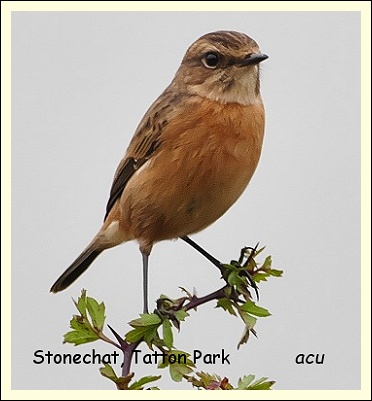 Willow Tits back at, what was, one of the species' more reliable sites. (Incidentally I believe Willow Tits nested at Rostherne in the Spring. The first record for over 20 years) Willow Tits back at, what was, one of the species' more reliable sites. (Incidentally I believe Willow Tits nested at Rostherne in the Spring. The first record for over 20 years)9.5km walk at Moore NR, Upper Moss Side, Manchester Ship Canal path to Wigg Island and back again; just notable species. Started at the feeding station at Moore, where volunteers have tidied up the area and starting feeding birds, only lingered for couple of minutes but a Willow Tit came in twice!! Good start... Continued to Upper Moss Side and disturbed a decent flock of birds (30+) which included Reed Buntings (1m, 3f), Yellowhammer, several Chaffinches, Dunnocks, etc. Next field there were at least 20 Curlews feeding. Then onto the canal towpath towards Wigg Island. Unfortunately, it was high tide on the Mersey River but on the way back managed to find a Little Egret and a large flock of Curlews. I'm always surprised why the canal attracts so many Tufted Ducks and small number of Gadwalls. But in all a superb morning with good weather and brilliant birds - over 40 species. Apart from local walks around the Pavement Lane area of Mobberley I've confined my activities to Tatton Park. last Sunday (15th) Bill Bellamy did the monthly wildfowl count and counted, in total and amongst others, 10 Goldeneye, 24 Pochard and 97 Tufted Duck, between Tatton and Melchett meres - the updated spreadsheet and be seen by [clicking here] Yesterday afternoon I was intending to walk from the Melchett car park up to Higmere Plantation but, just past the overhanging willow tree, I came across the female Stonechat that, together with a male bird, is again wintering in the park. It was quite suspicious of me at first but I just stood quietly for some time and eventually it seemed to accept that I wasn't a threat and posed nicely for the camera. 12/11/2020......100+ lockdown list!
Peter Dawson has continued with his lockdown list and currently it stands at an amazing 102 species seen, without the use of a motor vehicle, since March! I've been walking round Tatton Park most weeks since the start of Lockdown #1 and my count currently stands at ~77. Approximate only because I didn't start counting in the Park only until some time after the start of the lockdown. Unfortunately no Jack Snipe or Cetti's warbler yet. I did see a group of ~20 snipe flying out of and back into the marshy area next to Melchett Mere a few days ago but couldn't see anything other than common. Thanks Hugh and thanks Bob! 05/11/2020...... Singing Cetti's Warbler on the Moor
Not so now, unfortunately, it's colder, wetter and the nights are drawing in as we descend into the Winter months. There are though some important (for we birders) differences in that Tatton Park will remain open and it's permissible to travel to access locations for exercise and visit an outdoor public place. 7. You can take unlimited exercise
The message is very different now to March, when people were told to take only one form of exercise outdoors a day. At the moment I'm not planning to set up a separate page on the website devoted solely to activities during the current lockdown, as I did during the first. Given the time of the year, I'm assuming that people will be less active outdoors, nevertheless please let me know what you're up to, what you're seeing etc. and I'll include it in this section of 10X50.com. Currently most of the records I'm receiving are from Tatton. Geoff and Sheila Blamire often use the park for their morning rambles. Thanks Hugh, I hope you're right! 28/10/2020......More brief encounters
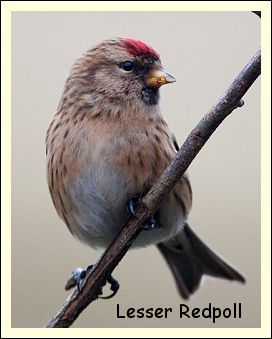 which came up over Briddon Weir Farm (I think) and hurtled into the Reserve, only to do a sudden about turn and head back like lightning to spook all the small birds in the big field. Don't think it was successful as they scattered in panic. In the same field 7 Fieldfares were feeding together, until the peregrine moved them. Good views of a female Kestrel which was flying low from wires and grabbing small prey from the ground. There weren't many birds on the mere that I could see. 11 Mute Swans together and a separate immature. A single Heron. Only a few Buzzards and they were very high. Single Nuthatch. A Mistle Thrush guarded holly berries from flighty Redwings. Flying off a Jay's white rump was prominent as the sunlight caught it. A highlight was close views of a handsome male Redpoll on seed heads at the edge of Cicely Mill Pool, where also 2 Little Grebes, 2 Mute Swans and a Heron flew in, probably from the mere. There was even a late dragonfly zipping about. The cloudsheet closed above but I left well satisfied with my sightings." which came up over Briddon Weir Farm (I think) and hurtled into the Reserve, only to do a sudden about turn and head back like lightning to spook all the small birds in the big field. Don't think it was successful as they scattered in panic. In the same field 7 Fieldfares were feeding together, until the peregrine moved them. Good views of a female Kestrel which was flying low from wires and grabbing small prey from the ground. There weren't many birds on the mere that I could see. 11 Mute Swans together and a separate immature. A single Heron. Only a few Buzzards and they were very high. Single Nuthatch. A Mistle Thrush guarded holly berries from flighty Redwings. Flying off a Jay's white rump was prominent as the sunlight caught it. A highlight was close views of a handsome male Redpoll on seed heads at the edge of Cicely Mill Pool, where also 2 Little Grebes, 2 Mute Swans and a Heron flew in, probably from the mere. There was even a late dragonfly zipping about. The cloudsheet closed above but I left well satisfied with my sightings."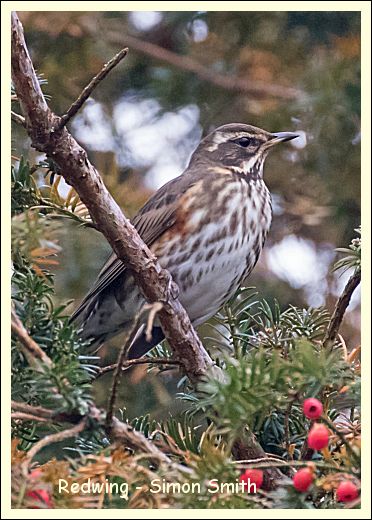 Encouraged by Bob's close views of a Redpoll I took myself off to Cicely Mill the following day, complete with the new camera. No luck, but I had Dabchick, 2 Teal, 2 Shoveler, GS Woodpecker etc. a pleasant afternoon in the Autumn sun - a great little spot. I was pleased to hear, last week, from Simon and Lyn over in Warrington...." We've been getting out occasionally. Went to the Lovell Quinta arboretum at Swettenham last week (
£
2.50 donation for entry, free to RHS members) and saw plenty of winter thrushes, goldcrests, tree creepers & nuthatches; as well as the usual suspects. The trees were excellent too and will probably improve this week & next, so we may return. The arboretum abuts Cheshire Wildlife Trust's 'The Quinta' nature reserve, which we noted to have a look at come Spring. By coincidence, the next day I was in Tatton heading towards the Mill Pool, when I bumped into the pair, they'd been in the mansion gardens photographing the autumn scenery. As the three of us made our way back from the Mill Pool we chanced upon Jude and Brian, that made five KOS members together, probably for the first time since mid-March, a reminder of how things have changed and just what we've been forced to accept in the past few months. The Stockport Birdwatching Society have again chanced a field trip; this time to Spurn Point - I think we'll be waiting until next year! [report here] 18/10/2020...... The Black-necked Grebe moves on The recent records from Bob Groom and the Blamires concerning the Curlew flocks around the Plumley and Allostock areas prompted an email from Mark Eddows. "Regarding Geoff and Sheila's Curlew at Allostock, I used to find good flocks of feeding Curlew in the brine fields near Plumley when I was walking the dog there 10+ years ago. When I was researching things further, I came across the attached article which might be of interest. It brings to mind Coward's comments on keeping records that you pointed out recently. Is it time for a repeat survey to see how things have changed?" You can read the article by clicking here. The author, Dennis Elphick, was very active in Cheshire in the 1970s and 80s, before moving to the south of England and was one of the co-authors of the first Cheshire breeding bird atlas, (copies of which are available online for as little as £ 4:99 - a real bargain, as it's a book that should grace the bookshelves of every Cheshire birder!) https://www.abebooks.co.uk As you'll see the Curlew exercise must have involved a lot of people and effort, something that would probably be difficult to replicate nowadays! A few Fieldfare records have filtered through over the past few days with birds seen at Plumley by Sheila and Geoff Blamire and a flock over Knutsford Little Tatton's juvenile Black-necked Grebe appears to have moved on, as has the youngster from Neumann's Flash. Hopefully when the Tatton bird returns in the Spring it'll remember it's time in the park and drop in, resplendent in its striking Summer plumage - who knows it may remain longer, the south end of Tatton mere would be an excellent place to breed! The Grebe's three week stay in the park generated a certain amount of interest and attracted a steady stream of birders, some of whom I'd not met for many years and, of course, the sight of telescopes or big-lens cameras attracted the curiosity of members of the public, giving a chance to do some PR work for the KOS and the handing out of our "business cards" - you never know! On Friday (16th) and, by way of a change, I had a walk through Dog Wood; it was a cloudy day and, with the trees still in leaf and a paucity of birds, a gloomy few minutes ensued - things only brightened up when the Blamire's appeared, on their daily workout! Geoff and Sheila though continued with what turned out to be a long trek. Great to see that the Stonechats seem to have returned for the Winter months, although the deer stalkers probably won't notice them. 12/10/2020...... The first Winter thrushes The first Redwings and Fieldfares of the season have appeared in our area. On Friday (9th) Maria Freel had a number of Redwings, feeding on yew berries, close to the mansion in Tatton Park. This is slightly later than last year, when a party of 50 were recorded in Rostherne village, on the 6th October, in the yew trees that overhang the Natural England car park. On the 11th Bob Groom had a number flying over Queensway in Knutsford, late in the afternoon. Yesterday (11th) Alan Gillespie heard and watched a flock of 20 Fieldfares as they passed over Tatton park. Again the first of what promises to be a long Winter. There have been more sightings of Pink-footed Geese. Geoff and Sheila Blamire counted a flock of 80 over Holford on the 4th; Derek and Jean noted 50 flying north-west over Tabley yesterday (11th) and two birders from Frodsham had 80 flying east over Tatton later in the day. They also saw a drake Pintail on the mere but seemed to have missed out on our little Black-necked Grebe that's been in the park for over three weeks now; it's very settled and perhaps it'll remain until later in the Winter when we may see the mere start to freeze over. Although, given the mild run of winters we've had recently, this may not come to pass! Sheila and Geoff are continuing with their daily workouts and recently they've seen some large flocks of over-wintering Curlews in the Allostock area - with 120 on the 4th of October and 44 yesterday (11th) in fields close to New Farm (SJ721736). Despite the onset of colder weather some Summer birds are still hanging on. The Blamires had 8 House Martins last Friday (9th) at Allostock and, in the same area, 13 Swallows the previous day and three yesterday (11th). Over in Merseyside Barrie Armitt continues with his daily visible migration counts from his vantage point on the Crosby sand dunes. Just 4 hours this morning - no staying power these youngsters!
04/10/2020...... Brief Encounters It's the tipping point of the seasons; Winter visitors are arriving and the last of our Summer birds are heading south. For a short period at this time of the year representatives of both briefly overlap. Last Sunday (27/9) Five Whooper Swans appeared at Northwich's Neumann's Flash, Derek Pike counted 70 Pink-footed Geese flying north over Knutsford and the first Redwings were seen in Warrington. Meanwhile a few Swallows The juvenile Black-necked Grebe remains on Tatton mere, Alan Gillespie watched it this morning (4th), showing well, close to the west shore; also there a female Goldeneye and a huge number of geese - including 23 Greylags. As well as the Tatton bird there's a juvenile Black-necked Grebe at Neumann's Flash but it's more difficult to see, unlike the park's confiding youngster. I couldn't locate it on the 29th but I did see a Cattle Egret on the island at the side of the flash; it's commuting between there and the Dairy House meadow and it was there when Bob finally managed to get across to see it after a morning in the company of the gas man! ".......... When the engineer left at lunchtime I weighed things up and decided birds came before food so off I went to the layby. It was certainly a long haul but it was well worth it with great views of the very active Cattle Egret over the gate. When the sun came out the bullocks lay down and the CE actually plucked ticks (or whatever) from their heads without them flinching - shades of east Africa......" Burton Mere Wetlands is open again and is providing some good sightings, including Pectoral Sandpiper and recently, 39 Great White Egrets! [ Click here for full access details] 25/09/2020......A visitor from Woolston With the lockdown beginning in mid-March we never had the chance to visit Woolston Eyes this Spring for the Black-necked Grebes but, by way of compensation, this week, on Tuesday (22nd), a juvenile of the species turned up on Tatton mere. 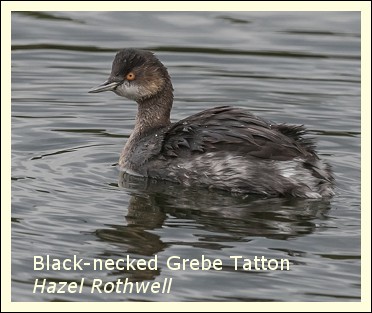 It was first spotted by Hazel Rothwell, who put some excellent photos of the bird up on the Manchester birding forum website, and it was still there this evening (25th), favouring the west shore of the mere, close to the main driveway from the Knutsford entrance towards the mansion. It was first spotted by Hazel Rothwell, who put some excellent photos of the bird up on the Manchester birding forum website, and it was still there this evening (25th), favouring the west shore of the mere, close to the main driveway from the Knutsford entrance towards the mansion.It is quite confiding, feeding in the shallows close to the shore, giving excellent photo opportunities. I even managed some half-decent ones myself but as Hazel was the original finder her image gets pride of place! Just 14
°
C today as we descend into an uncertain Winter, Swallows are moving south but there are still a few lingering on, Derek Pike had 12 at Fryer's Nursery on Monday (21st) and 8 the following day in Plumley. Cold weather birds are beginning to appear, Geoff and Sheila Blamire have Siskins back in their Mere garden, Darren Morris had a flock of 70 Pink-footed geese Bob Groom continues to attract Hobbies, his latest encounter came on Monday (21st) at Ashton's Flash After a stint at Pod's Hide chatting to Glynn, a birder from Crewe, we headed down to Ashton's Flash. Soon after arriving at the seat I spotted a juvenile Hobby which proceeded to entertain us off-and-on for nearly 2 hours! Wonderful views. Back and to, over and around the flash, often close, also perched for quite a while, despite the unwelcome attentions of 2 Jays At one point there were 4 raptors present, the hobby, a Kestrel, a male Sparrowhawk and 2 Buzzards together on a pylon! Counted 66 Curlews as well. Great..
The worst of the lockdown restrictions ended in time for Alison and I to get out to enjoy our local Nightjars in the Matlock Forest area - estimated 15 territorial pairs based on our records combined with those of a few other locals. Most pairs seemed to have fledged young, according to the records of one enthusiast who was still following them in early September. We didn't manage to see any young but plenty of adults were still around towards the end of August so we expect that they had young. We have found them also at other recently felled conifer plantations at Redmires and Burbage Brook this year in the Sheffield recording area. I understand two churring males were found in the Goyt this year which is not far at all from Macclesfield Forest. Is anybody looking out for them there? We made an unexpected observation of Nightjar wing clapping during one of our visits. In good visual conditions watching the birds fly directly away, silhouetted against the bright sky shortly after sunset, it was quite clear that the wings do not actually meet so the sound is not a clap as such. We had never realised this before. Looking at the literature we found Coward's note in British Birds from 1928 (see attachment) describing this observation but it appears that his explanation is not universally accepted. Once you have seen it there can be no doubt but, since the lighting conditions encountered when wing clapping is encountered are often poor, many observers maintain the misperception that the wing tips touch in a clap. We recorded the wing claps on a phone and the sonograms show two closely spaced but quite distinct beats for each wing clap which we understand to be the sounds generated independently by each wing by a flicking action without any contact between the primaries of the two wings. Our own recordings have been followed up with sonographic analysis of recordings on xeno-canto of the European Nightjar and other nightjar species. Were any of you aware of this? Nobody that we have spoken to about it seems to have known what Coward pointed out over 90 years ago.Mark has written a paper for publication, with their permission, I hope to put it on this website when it's complete. 19/09/2020...... Neumann's revisited Despite three recent visits to the local Hobby site Bob Groom hasn't seen any activity, so it appears they've moved away; earlier than 2019 when they remained until the first week in October. Tatton Ranger Darren Morris's record of a pair hunting dragonflies over the park's Mill Pool could well be the last we'll see of them until next Spring. Darren has kindly sent me a copy of the Tatton Autumn News Letter - [click here to read it]. Thanks Darren. Sheila and Geoff Blamire included Swains Way in their morning walk last Wednesday (9th) and were lucky enough to find a Wheatear that had paused on its journey south. It had moved on by the 14th when Bob visited the location but he did have a late Yellow Wagtail (I hadn't see one there all summer, though I know others had, and my good views had all been at Mobberley). Over in Merseyside Barrie Armitt continues with his early morning visible migration activities; his most recent Swift was on the 6th, although this is still early at Crosby - last year the final record came on 6th October! Yesterday (18th) I paid a long-overdue visit to Northwich's Neumann's Flash, spending a couple of hours in Pod's hide. The light was good and I was able to get some good shots with the new camera, especially of the Little Grebes that came within a few yards of the hide. Further away were Mallard, Wigeon, Tufted Duck, Teal and Shoveller, most still in dull post-moult plumage. A Water Rail called from the surrounding reeds and a Cetti's Warbler burst into song from time to time. Geoff and Sheila stopped by on their travels and it was Sheila who spotted a Great White Egret across the far side of the flash. The next visitor was an interesting character by the name of Malcolm Curtin who'd been alerted as to the presence of the GWE and was anxious to tick it off on his Marbury / Neumann's year list. Malcolm seems to like his lists https://bubo.org/View-user-profile.html?user=3881 ! In his own words Previous life as a publican raising kids etc meant just occasional twitching but been pretty full on for the last 10 years including 3 years of fairly manic year listing 2005-7,I'm better now though, The previous day (17th) had been quite a busy one for Malcolm - up at 2:00am - drive to Oban arriving at 8:00am - flight to Tiree in 8 seater light aircraft - tick off the Yellow-bellied Flycatcher (a first for the western Palearctic) - fly back to Oban - drive home to Comberbatch by midnight. The Stockport Birdwatching Society have actually had a recent field trip! They visited Frampton Marsh in Lincolnshire on 12th September !! http://stockportbirders.blogspot.com/2020/09/frampton-marsh-rspb-reserve-12th.html Different strokes for different folks!06/09/2020...... News of an old friend I'm asked occasionally what the Knutsford Ornithological Society is all about and what we get up to. I have a well rehearsed reply - "we're a group of like-minded people, from all walks of life, who have a common interest in natural history; birds in particular". That's what brought us together almost 50 years ago and it's still true today. Within our ranks we have many good birders, well able to identify, by sight or sound, the majority of species we're likely to come across. Nevertheless, despite our title, I don't think any amongst us would actually claim to be an ornithologist! That's not to say we don't come close at times, in particular during the fieldwork for various atlases - national and local, ongoing breeding bird surveys and wildfowl counts. We had another encounter with one of the more advanced sides of ornithology on our excellent overnight trip to North Wales in 2016. Our final stop on the return journey was at the Gronant Little Tern colony, where one of the images of the terns, taken by Sheila Blamire, showed the identification letters on a colour ring attached to its leg - XAC [click here]. Subsequently we learnt that the bird had been ringed in 2009 by Cheshire ringer, Professor David Norman, who recently sent Sheila an update on its progress. You probably remember taking an in-flight photo of Little Tern XAC over the beach at Gronant a few years ago. I had originally ringed this bird as a chick in 2009 and added the colour-ring when we started trapping adults in 2015. So there we are - a bit of "real" ornithology! Locally, Swifts are still moving through; at the moment the birds seen by Bob Groom and Geoff and Sheila Blamire at Neumann's Flash on Friday (4th) are the latest so far, although Barrie Armitt had one this morning (6th) at Crosby on Merseyside. I've no doubt there are more to come! We moved into the meteorological autumn on September 1st. The day before, and a sign of the changing seasons came at Neumann's Flash, when Jacquie Ledward had a Short-eared Owl. On Friday (4th) I had Meadow Pipits passing over Mobberley - the first of the Autumn. I also saw four Swallows moving through but they were heading steadily north! By coincidence, the same morning, Barrie Armitt noted 10 going in the same direction at Crosby. What's going on there? Answers on a postcard please. Following on from the decision by the WWT not to accept any adverts from anyone who promotes air travel, more wildlife wokery, this time in the well-respected "Birdwatch" magazine, who recently published an article by it's founder suggesting that the 800 species whose names recognise those involved in, linked to or honoured by their discovery should be scrutinised (and presumably, changed to something more appropriate if the suggested committee of worthies consider the person concerned undeserving in some way.) "[quote].........I'd prefer to see a joint committee established by the AOS and the IOC to draw up objective criteria against which all such names can be assessed.........". You can read it by clicking here. If you're a bit busy, perhaps leave it until 1st. April. NB 02/09/2020...... Chiffchaffs, Hobbies and something a bit bigger! After last week's disappointing visit to Woolston Eyes, yesterday (1/9) Derek and I decided to give it another go. Unfortunately some sort of traffic incident occurred at Mere and the whole of the road system in and around Knutsford was gridlocked, so in the end we ended up in Tatton Park, after an aborted attempt to get as far as Neumann's Flash in Northwich. Tatton was a good substitute though. It was quieter than of late (first day of the new school year) and the weather was great - a pleasant 14 ° C when we arrived rising to 20 ° C by 1pm. We walked up to the old hall, turned right and followed the route of the outlet stream as far as the Mill Pool, where Goostrey's sausage rolls were taken. Nothing special but en route we had Green Woodpecker, Treecreeper and a variety of small birds in Swan Clump, which you'll remember hosted a flock of Crossbills in February 1998! A Chiffchaff was in song somewhere in the undergrowth, Sheila and Geoff Blamire heard one at Cicely Mill last week and I've heard the species at three different locations this week when walking around Mobberley. Why do they sing at this time of the year? Answers on a postcard please. Returning to Melchett Mere we met up with Bob Groom, who had (naturally) two Hobbies in view across the far side of the mere, an adult and a juvenile; they were perched on the two dead trees over that side of the water, swooping down from time to time to catch passing dragonflies. Jacquie Ledward and Susan Middleton have been up in the Pennines doing a bit of twitching. A practice normally frowned upon in the KOS of course but they're only young and they'll no doubt grow out of it eventually!! Sue and I decided to go in search of the Bearded Vulture last (Sunday 23rd August). We parked at Crowden Car Park and had planned a circular walk around the area where the bird had been sighted.
When we arrived, the hills were already obscured with low lying clouds and it had begun to drizzle. Undeterred, we began our walk with thoughts of seeing the bird and great hopes of wonderful views. 25/08/2020...... Hobbies, Swifts and cheeky sods. A pleasant enough morning yesterday (24/8), 20 ° C and bright sunshine as I unlocked the barrier to the track leading up to the Woolston Eyes reserve. I had company too in the form of Derek Pike, our Hon.Sec. but despite the ideal conditions we both came away slightly disappointed having amassed a grand total of only 30 species at the end of almost three hours birding - perhaps we spent too much time "catching up"! It's been 5 months since we've been out together. Great to hear again from Phil Rowley who'd had late Swifts over Belvide reservoir last Friday (21st) and the previous morning he'd enjoyed excellent close-up views of a Hobby hunting dragonflies as he fished a small pit at Warford, near Alderley Edge. Swifts are still passing through on their way south, Bob Groom saw 3 at Neumann's Flash last Wednesday (19th) and following Phil's birds on the 21st I went into Tatton hoping to catch one or two over the mere on what was a blustery afternoon. No luck but I did count 15 Pochard and a substantial flock of 144 Tufted Ducks. Wendy Stratford tell me "her" three Barn Owl youngsters have successfully fledged and left their owl box, all three were ringed by members of the Mid- Cheshire Barn Owl Conservation Group. You can read it here https://doc.cheshireeast.gov.uk/NorthgatePublicDocs/08213166.pdf unbelievable - literally! It brings to mind a Russian word that has no English equivalent - Vranyo. "You know I'm lying, and I know that you know, and you know that I know that you know, but I go ahead with a straight face, and you nod seriously and take notes." 18/08/2020...... A pleasant morning at Woolston The hot days and equally hot and uncomfortable nights we've "enjoyed" for the past couple of weeks seem to be over for the time being, as low pressure systems move in from the Atlantic. Yesterday a temperature of 54.4 ° C was recorded at Furnace Creek [population 24], Death Valley, California; this will be the hottest August temperature ever recorded, anywhere on earth, if it's verified! It was somewhat cooler, just 17 ° C with occasional drizzle, as I made my way over to Woolston Eyes for a mornings birding. The numerous elderberry bushes on the reserve are laden with fruit this year and the LBJs were taking full advantage 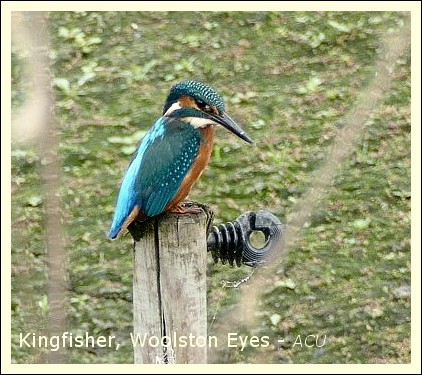 - Chiffchaffs, Willow Warblers, Blackcaps and Whitethroats being the most prominent, testing my skills with the new camera - must do better (or read the manual again). The Kingfisher, though, posed nicely in front of the Morgan hide and gave me a chance to try different settings, I even managed a few seconds of video [click here] - Chiffchaffs, Willow Warblers, Blackcaps and Whitethroats being the most prominent, testing my skills with the new camera - must do better (or read the manual again). The Kingfisher, though, posed nicely in front of the Morgan hide and gave me a chance to try different settings, I even managed a few seconds of video [click here]Black-tailed Godwits and Green Sandpipers were recorded on the whiteboard log but there were no waders when I was there, apart from a couple of Lapwings and a Snipe that dropped in on the far side of the water. A few hirundines passed through, Swallows, Sand and House Martins but no Swifts. Derek Pike's Swift record on the 9th August is the latest so far this year but there should be others later this month and even into September. All in all an excellent morning, with a final tally of 40 different species. Plenty of birds but few human visitors, I spent most of the time alone in the Morgan hide, there may be more at the weekend of course but you should be ok during the week. I'm not receiving many reports from other KOS members at the moment but the stalwart Bob Groom is, of course, very active. On Sunday (16/8) he did the monthly wildfowl count at Tabley....... Went over to Tabley Park after the rain. Limited range of species but some good counts - 23 Mute Swans, 140 Coot, 100 Mallard, 32 Tufties, 4 gt.cr.Grebes, 4 Herons, Cormorant... At least 50% of the water surface covered with pond weed, concentrating the wildfowl. Very steamy (and gloomy) in the wood with the high humidity.........Bob tells me the local Hobbies are still around but there is some question about how successful they've been this year. All we know for certain is that there is at least one young bird and two adults at the moment. News from Burton Mere Wetlands; Sheila Blamire tells me that one adult and two juvenile Spotted Crakes have been seen recently, so it seems they've bred there again this year. The latest edition of CAWOS' Bird News has details of forthcoming indoor meetings, beginning on the 2nd October with a talk by Jeff Clarke entitled "Why they flock (and other intriguing behaviours)" Announcements will be made nearer the time on the CAWOS website and via emails to members.
I've been over to the Woolston Eyes reserve a couple of times since it re-opened recently. Basically it remains the same as before the lockdown but there are restrictions on the number of people allowed in each of the hides. One or two for the smaller hides and four in the main Morgan building. Sanitising gels are provided and the wearing of masks is mandatory in the hides, it's also sensible to take along some gel of your own for use after unlocking the padlocks on the gates. I headed for Woolston this morning (3/8) complete with my new camera, hoping for some close up shots of birds feeding close to the Morgan hide. Yesterday (2/8) I paid my first visit this year to Bob Groom's Hobby site just a few miles from Knutsford. I wasn't disappointed, the birds are thought to have well-grown young by now and I was treated to plenty of activity as one of the birds patrolled the area, seeing off any intruders. The still images I took left a lot to be desired but, after consulting the manual, I managed to get some passable video footage of one of the pair persuading a Buzzard to vacate the area. (It should appear below!!)
Bob was there in the afternoon, so I'll leave it to him to describe some of the goings on!......... The male Hobby was on guard as I arrived. As a buzzard started calling the female flew out and round but at this point the big bird wasn't visible. The two hobbies perched side by side briefly and the size difference was noticeable but not appreciably significant, unlike say sparrow hawks where the female is a third larger than the male and has a different menu. The male then went off hunting and came back with prey which it took into the big tree before resuming guard duty. Considering it was on watch it didn't take much notice of the buzzard racket whereas the female kept coming out to investigate and have a fly round. As a Peregrine circled both Hobbies sat tight, the female at the edge of the nesting tree and the male at his lookout. This seemed sensible to me, a buzzard is no real threat to an adult hobby but a peregrine could be a different story. Once it had departed the male Hobby flew off. A little while later it arrived back and there was a lot of calling, which I interpreted as the female telling off the male for only bringing in insects! 26/07/2020...... The one hundred day bird I remember once reading that, in parts of France, the Swift is known as the "100 day bird" (although I've not been able to find any reference to it on the internet); still it's an appropriate name as they spend about 100 days with us each summer, before returning south to Africa. Amongst our KOS members, Jacquie Ledward recorded the first this year, on the 25th April, at Marbury and now, 93 days later, fewer and fewer are being seen locally. Bob Groom counted around 150 last Tuesday (21st) over Tabley Hill.... 150+ Swifts over Tabley Hill/ Moss Lane area (hay and crop cutting taking place), also a few Swallows and one or two House Martins. Hypnotic spectacle! Several Buzzards getting in on the action, also a circling Peregrine.......... Five days later, more - plus his 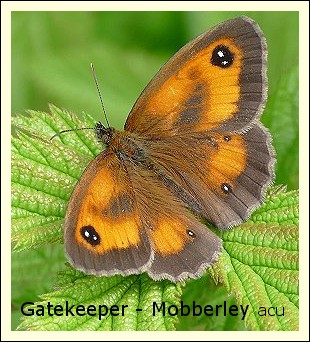 usual Hobby sightings!.....Green Lane - 3 Swifts, a few Swallows, lots of Meadow Cranesbill.. By the time I got to Tabley Hill Bridleway the sun was actually coming out. A dozen Swifts appeared and spent some time zipping round, later I had two more sightings of a dozen Swifts but whether same or different couldn't say. usual Hobby sightings!.....Green Lane - 3 Swifts, a few Swallows, lots of Meadow Cranesbill.. By the time I got to Tabley Hill Bridleway the sun was actually coming out. A dozen Swifts appeared and spent some time zipping round, later I had two more sightings of a dozen Swifts but whether same or different couldn't say.Greenfinch flew from the usual hedge, Tree Sparrows in the rape field, which was just cut in a strip alongside the track. Then, joy, a Hobby appeared, quite low then slowly gained height as it circled (perhaps in a thermal) before drifting away west. Several Buzzards about, one at hedge height. Walking back, the Hobby (or another) reappeared and circled round with the Swifts (but didn't make a move on them) before suddenly accelerating away fast south. Great stuff. Also Red Admiral and Meadow Brown butterflies..... The previous day Derek Pike noted encouraging numbers still around one of their traditional nesting areas in Lilac Avenue.....This afternoon 12-14 Swifts flying and screaming round Lilac Avenue, the most I have seen for three years around here ....... Both Derek and I noticed Canada Geese back on the wing after their annual moult - two small flocks, both over Mobberley on Thursday (23rd). Wendy Stratford tells me that the Barn Owls that have bred a short distance from her house were ringed on the 19th July (3 chicks). Also seen during the This week the latest edition of "Waterlife", the Wildfowl and Wetlands Trust's magazine dropped through the letter box. They will now publish just three editions a year (four currently). Perhaps they're looking to offset the loss of revenue that will surely result as a consequence of their decision to "no longer take advertising from companies that promote air travel". If the data is available, I'm sure they'll see that the majority of members are the sort of people who have the necessary time and money to take one or two foreign holidays each year. Exactly the audience the travel companies want - talk about cutting off your nose to spite your face! 15/07/2020...... No KOS meetings until at least the New Year Our KOS Secretary, Derek Pike, has sent out an email to all members regarding the current situation with Covid-19. I know not all regular readers of this website are members of the society, so for their benefit and any others that pass this way, I'll summarise the decisions of the KOS committee. Basically due to the multitude of uncertainties caused by the ongoing virus we won't be meeting as a group, either indoors or outdoors until at least the start of 2021. Towards the end of this year the situation will be reviewed and members will be informed about any decisions made by the committee. As usual it was Treasurer Frank Dearden who summarised the current situation in his own inimitable manner "Sheila's concluding comment that no one has renewed their subscriptions and therefore we technically have no current members is correct. And we have no programme because it is suspended. And we, ourselves, are not members. So the KOS does not exist. So what are we worrying about and why am I writing this email..... " A man of few words our Frank! Personally I think it unlikely that we'll be meeting indoors again for a long time but there's a chance for some outdoor get-togethers, should the current restrictions on group sizes be relaxed a little. Some good news from Woolston Eyes where the reserve is to re-open but groups won't be allowed.
We are pleased to announce that Woolston Eyes Reserve will be re-opening for Permit Holders from Saturday 25th July, with certain provisos. So we will be able to travel over to one of our favourite birding spots once again but only as individuals. Members are still getting out and about, despite this being the quietest time of the year for birdwatchers. Geoff and Sheila Blamire continue with their very impressive daily hikes and have now covered 525 miles (840Km) since the start of the lockdown - that's taken them now to just short of the Orkney Islands! Last week found them in Tatton where they discovered not one but two juvenile Redstarts! We walked to Mill Pond area but didn't expect to see the juv Redstart because we don't linger on our walks. Went to the fence on the left of the gate (not the bench side) and spotted a Green Woodpecker (female) on one of the fence posts. Then on the next fence - there it was - juv Redstart! Within a few minutes of arriving!! Got closer (so boggy there) and watched it fly down to the tussocks and back on the fence with the 'usual' quivering red tail. Then a Chiffchaff landed next to it, followed by another bird. We couldn't believe it - a 2nd juv Redstart!!! They were always on the fence, some distance from the gate. The Green Woodpecker was always around and the same area as the Redstarts. Went over this morning and had plenty of good sightings. 7 Swifts plus 20+ Swallows/House Martins over Gleavehouse/Pavement Lanes. Lots of Tree and House Sparrows. 4 Oystercatchers flew over, calling. 2 Whitethroats and 3 Linnets. Kestrel (seen several times), Buzzards and a female Sparrowhawk. Cormorant. There were many more Swifts really high over the fields as it brightened a little. 2 Skylarks. Reed Bunting. Disappointingly didn't see an adult yellow wagtail but did see no less than 4 juveniles! Very big gathering of corvids (all 3 regular species), creating quite a racket.. (no butterflies..) Perhaps a slight change in emphasis here in Bucklow Avenue. Olwen has bought me an all-singing, all-dancing Lumix FZ-1000 camera for our 49th wedding anniversary, it comes with a 96 page basic manual! I don't know if she's concerned that I'll not last another 12 months but it'll take until our 50th to plough my way through that manual anyway! Still it's a nice piece of kit and I'm looking forward to providing some record snaps of my own for this bit of the KOS website. Has anyone been up to the Pennines to twitch the Lammergeier (Bearded Vulture) that's been hanging around for a few days and has been seen as far east as the Goyt Valley? There's a good report here. The first of the two Dyfi Osprey chicks fledged yesterday (Tuesday) and it's worth watching today for the second to take it's first flight, expected sometime today [click here] 1/07/2020...... Tatton's Redstarts again! The weather's become more unsettled over the past couple of weeks with periods of heavy, squally showers sweeping in from the west; a pity that the hides at Woolston and Rostherne remain closed for the time being, they're always welcome refuges during intervals of inclement conditions. 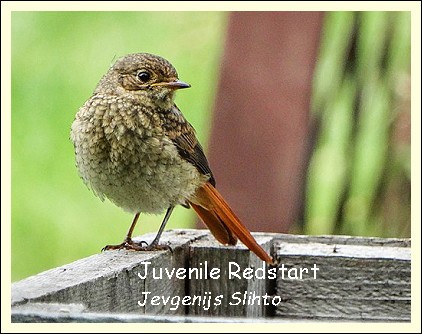 I've been to Tatton a few times, not much on or over the two meres, around 250 Canada Geese are moulting on Tatton Mere and a flock of 57 Tufted Ducks was present on Melchett last Sunday (28/6). Good numbers of Swifts and House Martins, with the occasional Swallow, were feeding low over the water and in the lee of the park's woodland during the high winds. I've been to Tatton a few times, not much on or over the two meres, around 250 Canada Geese are moulting on Tatton Mere and a flock of 57 Tufted Ducks was present on Melchett last Sunday (28/6). Good numbers of Swifts and House Martins, with the occasional Swallow, were feeding low over the water and in the lee of the park's woodland during the high winds.Yesterday (30/6) I ventured into the park again, it was very busy so I parked at the Old Hall and made my way over to the Mill Pond for some peace and quiet. Initially there was nothing of note - a Green Woodpecker calling in the distance, Coots feeding their noisy youngsters were joined by a Cormorant flying in from Rostherne mere and a Reed Bunting, still in full song from the nearby reed bed; nevertheless a good place to spend an hour or so in a tranquil and relaxing setting. I was about to return to the car when a bird landed on the wire of the locked gate leading to the private deer park, for a second I though it was a House Sparrow, a scruffy little individual (yes I know - listen who's talking!) but it's quivering tail told me it was something "different" and when it flew to an adjacent tree I was delighted to see it's orange / brown tail and rump - a juvenile Redstart! With Darren Morris' male on the 23rd of April and Nicholas Webb's pair on the 14th June, this bird is surely as close as we'll get to confirmation of Tatton's first breeding record of this species for decades. 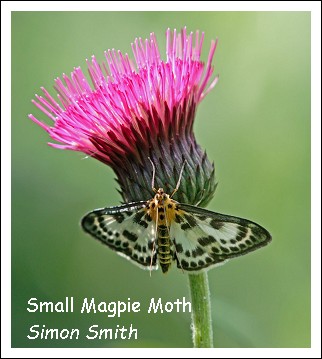 It was still there, giving good views, this morning when I was joined by Bob Groom, the Hon.Sec. and Mrs. Brookes; later in the day Darren watched it and reports a Great Spotted Woodpecker and a juvenile Green Woodpecker both on the same fence post at the same location! It's surprising what turns up if you just sit and let the birds come to you. A poor life this, if full of care, we have no time to stand and stare - W.H. Davies. Bob tells me "his" Hobbies are back at their now traditional site just a few miles from Knutsford, Geoff and Sheila Blamire also saw them at the same location, so we may see more of them later in the season. Last year it was well into October before the final sighting of the year. I swapped emails today with Simon Smith, he reports that all is well with he and Lyn over in Warrington.......... We're spending a lot of time working in the garden and consequentially are seeing a few unusual moths in daylight - the attached Small Magpie made a nice portrait........ Thanks Simon - you're not loosing your touch! Malcolm Calvert kindly sent me details of a remarkable Reed Warbler that was controlled (re-trapping of a previously ringed bird) recently at Rostherne Mere Recent trapping has produced information of much value in the study of
Reed Warbler longevity with two birds from 2015 and two from 2016. Thanks Malcolm and keep up the good work! 23/06/2020...... 20,000 birds ringed at Rostherne! I've mentioned before the ringing exploits of Malcolm Calvert, especially at Rostherne Mere. Bill Bellamy tells us that Malcolm ringed the 20,000th individual on Saturday (20th)
Congratulations Malcolm!............ Bill. Unfortunately the reserve's observatory is still closed and there's no date, as far as I know, for any re-opening. I've not been down to the field pool, to the east of Mobberley's Gleavehouse Farm, for some time now. On my last visit the field was full of cows accompanied by a very large, well-equipped black bull! They have now been moved to another location and Bob Groom retuned home safely after a visit on Saturday. Having received the good news that the house painters will be here on Wednesday I decided to celebrate with a walk in Mobberley. Sunshine, a nice breeze and fine weather, the perfect ingredients. Lots of Skylarks were up in song or chasing. Tree Sparrows frequently seen. At least 4, possibly 5 Yellow Wagtails seen. One of the three females did a distraction dance, leading me down a path that I was following anyway, flying round and frequently perching. Another had a brief encounter with a male Yellowhammer in a hedgerow, where later I saw 2 of that species. I lingered at the field pool serenaded by the sweet song of a cock Linnet as I watched adult Swallows feeding young birds on the wing and tree perching. Also several House Martins flying round. OK, not as exciting as in spring but there were 2 Oystercatchers, 2 Shelducks, a female Mallard and a Pied Wagtail. Buzzards passing, but no other raptor seen. A couple of Rooks flew past, cawing. A veritable swarm of Small Tortoiseshell Butterflies but, surprisingly, there was only one other coloured species, a Gatekeeper. Also a few dragonflies. Suitably inspired by Bob's eloquent description, I headed in that direction the following day. There were an encouraging number of Swallows and House Martins at the new Blackthorn Farm, with it's open barns either side of Gleavehouse Lane. As Bob found there were numerous Skylarks in the area and his Yellow Wagtail escorted me from the premises as well! I "filmed" the wagtail with my phone camera - you can't identify it except by it's distinctive call - another KOS record shot! click here. Geoff and Sheila Blamire continue with their punishing series of walks, including this week a trek around Tatton Park.
We ventured into Tatton Park this morning.
We parked in the layby, waked through Dog Wood (a lot of bird song), beside Tatton Mere (5 Egyptian Geese on the jetty), walked to the Mill Pond, over to Millennium Wood, back via Melchett Mere, along the side of the mere to Knutsford Gate, by the moor (Great Crested Grebes with their 3 large humbugs) and back to the car. Good walk 8km. A bit of excitement this afternoon from the decking, as a tight group of five high-flying birds passed over heading west. Initially I thought they were gulls but when I got the binoculars on them I could see they were waders with long straight bills. Presumably Black-tailed Godwits heading for Burton Mere Wetlands, where a substantial flock start to build up at this time of the year. 17/06/2020...... Redstarts Breeding in Tatton After the judicious use of Ibuprofen and a strategically placed hot water bottle my back problem has been resolved. I did though spend a few more days relaxing on the decking at the back of the house. Again, plenty of activity amongst the local population but very little on offer in the sky above. No Swallows, the occasional House Martins from a local colony and just a couple of Swifts from time to time. So I was pleased that Tatton Park has re-opened and I was able once again to take advantage of my season ticket. My first visit was last Wednesday (10/6)  followed by repeats on the following two days. The weather was decidedly cooler, reaching only around 15C, with some blustery conditions on each occasion. Nevertheless there were plenty of visitors and those with dogs were following the published guidelines and keeping their pooches on leads. followed by repeats on the following two days. The weather was decidedly cooler, reaching only around 15C, with some blustery conditions on each occasion. Nevertheless there were plenty of visitors and those with dogs were following the published guidelines and keeping their pooches on leads.Birdwise it was disappointing; a flock of around 80 Canada geese were preparing for their annual moult on the main mere (I counted only 3 young birds) whilst on Melchett, Greylag Geese had more youngsters with 7 (5+2) among a small flock of 19. Interesting news though from park ranger Darren Morris, who tells me that a visitor to the park on Sunday, saw two Redstarts at the Mill Pool, a male and a female, the male was carrying food. This is the same spot where Darren recorded a male on 23 April this year [Not a good image I'm afraid but it's authentic. There are thousands of Redstart pictures on the web I could have used but we do like our record shots in the KOS!] Some members have been further afield, Neumann's Flash in Northwich has been a favourite spot and continues to come up with the goods. Geoff and Sheila Blamire have kept me up to date with their visits. Some highlights from today: Neumann's Flash: Avocet (breeding attempt failed, probably due to predation at egg stage) and 3 Little Ringed Plovers on Stilt Island. 2 Oystercatchers on the island (now shrinking and overgrown, with a dead swan) - 1 appeared to be on a nest. Plus Cetti's. Ashton's Flash: pair of Shelducks with 8 ducklings, 2 Redshanks, 2 Little Ringed Plover. Plus Cetti's. Dairy House Meadows: great view of Cuckoo at top of a tree, calling continuously, then I was distracted by a Buzzard flying very low overhead carrying a vole disappeared into the wood! After a few minutes the Buzzard reappeared (minus vole) and flew towards the Cuckoo which made the Cuckoo fly - straight towards us and perched next to us on a small tree and started calling with increased vigour! All the time there was a Cetti's singing nearby. Further down the track set up the scope to look into a Barn Owl next box. Before, there were always 2 Stock Doves, but now a Barn Owl was in the entrance while 1 dove was on the top of the box with the 2nd dove looking at the owl in the entrance trying to decide what to do!! Budworth Mere: Great Crested Grebe female on a single egg in a very flimsy nest, while the male was being extra sticks to increase the height of the nest. Kidbrook Spit: Oystercatcher and 2-3 Ringed Plovers. Big Wood: always hear Goldcrests - from different areas, including some paths which are rarely walked. A great walk - just over 8km.Bob Groom has also visited this local hotspot. I decided to ignore TV/radio forecasts of rain and stick with M.O. prediction of a fine morning, which proved to be correct. No birders around on arrival. Did the longish (for me) trek from the car park to the pool (yellow flags and dragonflies). One false alarm, a bird in a big oak, brownish and the right size quickly proved to be a Garden Warbler, which then gave excellent views. Good views of regular species, Great Spotted Woodpecker (a female, closely accompanied by a begging youngster), Chiffchaff, plus Mistle Thrush and Jay in a field. Also around, Blackcaps, Nuthatches, Wrens, Robins... Frequent Buzzard sightings but not a single swift, swallow or martin! Small tortoiseshell and speckled wood butterflies. When I got back to the car park a local lady litter picking said the flycatchers had actually been seen round the car park (!) but she thought they may have gone. I then spent an extra half-hour looking but no luck. Nice, reasonably quiet woodland walks (though getting busy by the time I left) but I gather it can often be very noisy when Oulton Park is in session.. ( Several people asked me about the birds and showed a bit of knowledge so it looks as if Springwatch is doing good work.) The RSPB's Burton Mere Wetlands is open again although the visitor centre and the hides are closed. The toilets are open. Martin Mere is also open but you have to book in advance. https://www.wwt.org.uk/wetland-centres/martin-mere/plan-your-visit/prices/ 06/06/2020...... Red Kite and Hobby May was the sunniest month since records began; not just the sunniest month of May but of any month - ever! All good things must come to an end of course and currently our weather is being dominated by a large low pressure that has arrived from the Atlantic with high winds, heavy rain showers and temperatures 10 ° C down on last week. It seems to have suited early nesters and I've spent a few days in the garden, sat on the decking [bad back caused by old age and poverty] watching the comings and goings on the feeders. 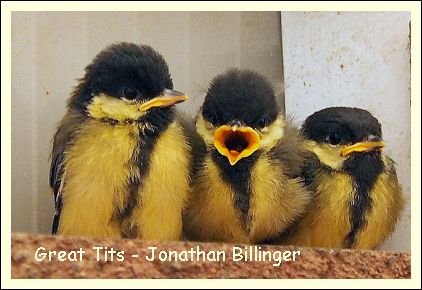 We don't put out seed at this time of the year, just high energy fat balls in two feeders - one the usual single cage and the second with an inner and outer container that gives access only to the smaller species. The simple feeder can be emptied in a day by the Jackdaws and Starlings but they can't get at the food in the double feeder and this is popular with House Sparrows and especially Blue Tits with a family of two adults and 6+ youngsters with us for most of the day. A pair of Great Tits though prefer insects taken from a tangle of clematis and honeysuckle growing on the trellis and ferried across to the five chicks lined up expectantly on the fence. We don't put out seed at this time of the year, just high energy fat balls in two feeders - one the usual single cage and the second with an inner and outer container that gives access only to the smaller species. The simple feeder can be emptied in a day by the Jackdaws and Starlings but they can't get at the food in the double feeder and this is popular with House Sparrows and especially Blue Tits with a family of two adults and 6+ youngsters with us for most of the day. A pair of Great Tits though prefer insects taken from a tangle of clematis and honeysuckle growing on the trellis and ferried across to the five chicks lined up expectantly on the fence.More breeding success down the road along Smith Lane where Wendy Stratford's Nuthatches have fledged, in Mere with a Great Spotted Woodpecker feeding sunflower hearts to a youngster in Sheila and Geoff's back garden and in Lilac Avenue where Derek and Jean recorded a family party of Tree Sparrows on Monday (1st). The following day Jean was lucky enough to hear a distant Cuckoo calling from the direction of Tabley Park. Still on the garden bird theme both Jude Halman and Bob Groom have added new species to their lists - Red Kite! Jude on the 28th May and Bob on the 3rd June; what was probably the same bird as the one seen by Jude passed over Mobberley a short time later, seen by Len Mason who had the same species two days later at the same location. Derek phoned the Gauntlet bird of prey centre to see if they'd lost one - they do have a Red Kite but it was safely ensconced in it's quarters at the time, so we assume the bird seen by our members was genuinely wild. As the tentative easing of the lockdown continues Tatton Park has re-opened; just the parkland for the first week but from Monday both the park and gardens - from 10am until 7pm. Park ranger Darren Morris has kindly sent us a copy of their Summer news letter [click here} Bob Groom was first off the blocks and was straight into the park on Thursday (4th).........Pretty much the first bird I saw was the Red Kite, almost as if it had been waiting for me! It was flying low, along the line of trees leading to Moss Wood. Third sighting in a few days, having seen it (I'm presuming the same roaming bird) in Plumley and then from my garden yesterday. There were many House Martins low round the trees and within the hour an impressive gathering of 60+ Swifts over Melchett Mere. Quite a sight. Tatton Mere itself had 100+ Swifts but there was probably some overlap. Also at least 2 dozen House Martins (but not a swallow to be seen), some at head height! At the mereside there was a sudden sharp shower and a Hobby flew across the south end of Tatton Mere to round off my visit nicely......... Next in, yesterday Geoff and Sheila Blamire ...... We parked in Dog Lodge layby and walked through into Dog Wood. The wood was so green, so overgrown - brilliant. Walked to the mere then the heavens opened. The upside was the literally hundreds of Swifts and House Martins descending to feed over the water. This was something to be repeated over the full circuit. I saw at least 2 Swallows and 1 Sand Martin (!). I was surprised about the number of Coot nests very close to the path - hope the increased number visitors and dogs doesn't put them off. Tomorrow it will be three years since our KOS trip to Speyside [join me in looking back by clicking here] - Happy days! 27/05/2020...... A puzzle solved? During the recent lockdown period we had numerous local records of Oystercatcher, especially at the field pool to the east of Gleavehouse farm in Mobberley. A pair were present most days with copulation noted 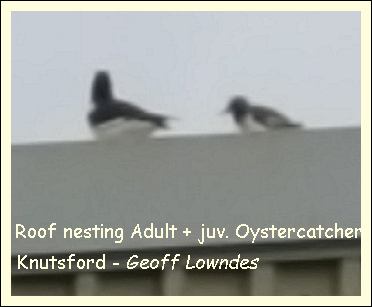 from time to time, so it was a fair assumption that they had a nest somewhere in the area. We never located the site but an email from Geoff and Lynn Lowndes received over the weekend has perhaps shed some light on the situation. Whilst walking through the Parkgate industrial estate, they saw an adult and a juvenile Oystercatcher on the roof of the Howden's joinery building, the record shot provided by Geoff shows a well-grown youngster but not yet big enough to fend for itself. It's only about a minutes flying time from the previously mentioned pool so it's assumed these are the same birds and they have nested on the roof of the business. from time to time, so it was a fair assumption that they had a nest somewhere in the area. We never located the site but an email from Geoff and Lynn Lowndes received over the weekend has perhaps shed some light on the situation. Whilst walking through the Parkgate industrial estate, they saw an adult and a juvenile Oystercatcher on the roof of the Howden's joinery building, the record shot provided by Geoff shows a well-grown youngster but not yet big enough to fend for itself. It's only about a minutes flying time from the previously mentioned pool so it's assumed these are the same birds and they have nested on the roof of the business. Unlike other waders that can feed themselves within hours of hatching, Oystercatcher chicks initially rely on their parents to bring them food rather than finding their own, so being up there wouldn't be too much of a problem, although predation by Lesser Black-backed Gulls that were patrolling the area when I went down would be. There's an interesting article here and also in the latest Cheshire atlas click here. Geoff and Sheila Blamire drove over to the airport to listen for the lesser Whitethroat. It was still there, along with numerous Common Whitethroats - Geoff has posted a nice video of the latter on Youtube [click here]. They had a very pleasant surprise when passing the fishing pit - a singing Cetti's Warbler - needless to say it had moved on the following day when I went down! Bob Groom tells me he had a Hobby close to it's traditional territory, not too far from Knutsford, there have been quite a few recent reports locally so it could be a good year for the species. More Swifts have returned but the general consensus is that numbers this year are well down on normal. We had hoped to do a Springtime birdwatch this month with the Friends of the Heath but due to you-know-what it didn't take place. Nevertheless Kevin Griffiths and his wife Terry did a survey of the nest boxes and found the majority occupied. A real success story! http://www.friendsoftheheath.org.uk/nest-box-survey-may-2020 The 2019 Rostherne Mere Bird Report compiled by Dr. Bill Bellamy has been published, covering, not only the birds but also Butterflies, Dragonflies and Damselflies found on the reserve. Steve Barber's analysis of the CBC is included as well as Malcolm Calvert's ringing data. Since 1972 Malcolm has ringed no less than 19,846 birds! Malcolm has also circulated a short account of his love affair with Reed Warblers, there's surely no one who knows this species any better then him! [Read Malcolm's account here] Another timely report comes from Greg Baker - Marbury and Witton Flashes 2019 Bird Report - A very comprehensive account of the birds at this ornithological hot spot. 19/05/2020...... Lesser Whitethroat The covid-19 lockdown has temporarily turned many peoples lives upside down and for some the virus has brought with it permanent, sometimes tragic, changes. Personally we're fortunate in having such good neighbours 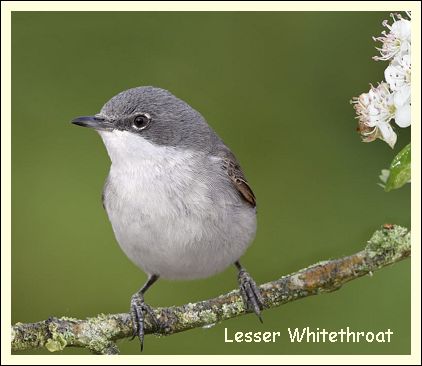 and family who have been willing to do our shopping, allowing us to successfully self-isolate for the past couple of months. and family who have been willing to do our shopping, allowing us to successfully self-isolate for the past couple of months.So it's really of no consequence that birding has been "different" since the end of March and I should count myself lucky that I've been able to get out and about on most days for a couple of hours exercising in the very pleasant Mobberley countryside. I've survived so far without Goostrey's sausage rolls and many Summer migrants are still missing from my year list - I'll happily manage without most but I was hoping to hear the song of a Lesser Whitethroat before they stop singing around the end of May. It's my favourite bird. The easing of restrictions this week has meant that I could drive to the birds' favourite areas in a few minutes rather than struggle on foot with a 7K round trip just to get to the appropriate area. No luck on Friday (15th) along Breech House Lane, their stronghold for many years, so the following day found me on the airport walk; in a clockwise direction from crash gate 11 at the end of Wood Lane - success! A bird was in song from a tangle of vegetation just before the track drops down to the Bollin tunnel, there are some convenient concrete blocks there to sit on and enjoy the performance, and currently of course - no aircraft noise. Geoff and Sheila Blamire are still eschewing the use of their cars and continue with their daily walks from home in Mere. They're certainly racking up the miles ...... going north we're just south of Perth, going south we're swimming the English Channel heading to France!.....On most days they've taken in Cicely Mill where Cetti's Warbler has been heard in song and Grey Wagtails and Great Crested Grebes have bred successfully. The Treecreepers the couple have been monitoring in Rostherne's Wood Bongs have also fledged - Geoff has put a nice little video on Youtube [click here]. Bob Groom's been over to Tabley Park where he heard a Cuckoo on Sunday (17th) ..... Setting out for my WeBS count this morning I saw a Hobby over Queensway! Another surprise awaited at Tabley Park, a Cuckoo calling in the wood! I tracked it back and to but with the trees in full leaf and off-path vegetation impassable, the only view I got was when it flew across a corner of the mere. (Keeper) Ernie Hart had 2 calling there this time last year but he said that both were taken by a Sparrowhawk within 2 or 3 days of each other. He's recently had hobby catching insects over the mere. For the 17th year running the House Sparrow has come out on top of the list during the RSPB's January "Big Garden Birdwatch" despite the fact that, locally, it has disappeared from many gardens [results click here]. 12/05/2020...... Cautious Optimism The latest guidance from the government will apparently allow us (from tomorrow - 13/5) to travel by motor vehicle to our favourite locations for a spot of birding. You will be allowed to meet up with one other person who's not from your household as long as you're outside and keep at least 2 meters apart. It's a controversial move, especially with the thousands of expert epidemiologists now infesting social media outlets, we're walking on egg shells with this virus, it's not going away any time soon and an effective vaccine is our only hope for a return to normality. Air travel will be out of reach for the vast majority of people and I fear 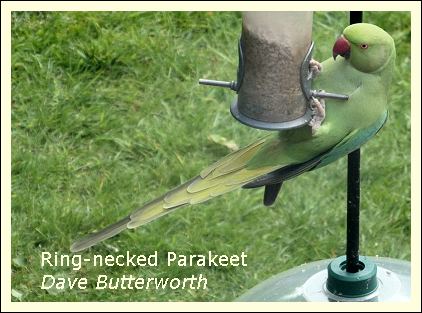 it'll be a long time before the KOS resumes it's traditional activities. it'll be a long time before the KOS resumes it's traditional activities. We've had to restrict our activities this Spring and lower expectations; gone are the days of Spoonbills, Little, Cattle and Great White Egrets at Burton, Black-necked Grebes at Woolston, Tern passage at Tatton and Rostherne etc. etc. These have been replaced by local rarities and highlights. Back to basic local patch bird watching; nevertheless we've made the most of things and there have been many highlights amongst the 300+ emails I've received over the past 6 weeks - Osprey over the Moor : nocturnal migration of Common Scoters over Warford and Marton: the spread of Ring-necked Parakeets : Redstarts at Bonsall and Tatton : Whimbrel over Marton : breeding Cetti's Warbler at Cicely Mill : A whole host of sightings from Marbury Park (admittedly a "hot spot" at any time!) : Ravens breeding in Mobberley : the re-discovery of the Mobberley field pool which provided us with early Yellow Wagtails and Little Ringed Plover plus Ring Ouzel and Goosander as well as numerous Wheatear sightings on the nearby paths. I believe Geoff and Sheila Blamire's lockdown list has now reached #80, which goes to show what's available on your doorstep for those with enough energy to make the effort and who are lucky enough to live in a suitable location. My car's been on the driveway for the past 6 weeks and only been fired up occasionally to charge the battery, I estimate it's doing about 20 weeks to the gallon, so I'm looking forward to driving up to crash gate 9 rather than walking and, hopefully, hook up with a Lesser Whitethroat before they stop singing. 12/05/2020...... Making the most of the Lockdowns 26th March 2020 to 12th May 2020 During the two periods of lockdown due to Covid-19 a daily compilation of emails received from KOS members and friends was distributed and a collection of individual pages added to the website. Over 300 emails from 40 individuals were received and they can be viewed by clicking on this link.
23/04/2020...... Email compilations continue The compilation of emails received from KOS members and other folk is ongoing and I'm hoping to continue with a daily offering for as long as I get enough material submitted. It's proving to be well received and so far 35 different people have sent me records of what they're up to during the lockdown on their local patches or memories of birding in more normal times. Contributions have been received from as far north as Cumbria and from Blithfield in Staffordshire in the south as well as Barrie Armitt's Crosby records from the west coast. Each days summary is also available on this website and will be a record of our activities during this extraordinary period, they can be accessed by clicking here As far as the rest of the natural world is concerned things are progressing as normal with the departure of our Winter friends and the arrival of the Summer visitors following their normal sequence and times. Currently Terns are passing through in large numbers and we're looking forward to the arrival, in the next few days, of our Swifts. Later on, if we're lucky, waders moving through the UK to more northern lands will be seen at local "hot spots" - what about Ruff and Wood Sandpiper on the now famous Mobberley field pool! The emails I receive are mainly just cut & pasted (with a few obvious spelling and grammatical errors corrected) and offered "as is". Within our membership we have people with a wide range of birding experience and I've not been inclined to offer any criticism or suggest changes to what I've received - things could get very messy and complicated and I like to have the latest compilation done and dusted by 8pm. Swapping emails and texts as midnight approaches just doesn't appeal!! I think it unlikely that, with perhaps just a couple of exceptions, any KOS members will ever be submitting their sightings to any County or National "rarity committees". I've never done so in 70+ years of birdwatching but nevertheless our own County Recorder Hugh Pulsford makes some valid points in his email appended below. Hi Tony As County Bird Recorder and BTO Representative for Cheshire I just want to urge caution amongst folks of claiming Goshawk sightings locally. Firstly it is a County rarity (and therefore requires a description for acceptance into the county database.) 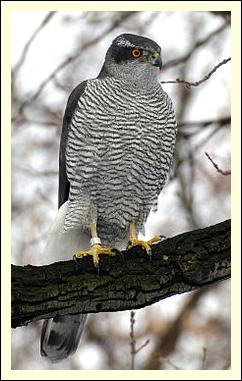 Secondly as the individual who submits annual rare breeding records to the National Rare Breeding Bird panel, I know where Goshawks are in Cheshire, (there is a small network of Schedule 1 licenced nest finders who follow up on sightings) and more importantly, where they are not. Thirdly and please don not take this as a criticism, but they are a notorious "beginners "bird, probably the one species in the UK that is most routinely claimed, but not proven, so identification require extreme care. (this is regularly commented on in many bird ID guides)
Female Sparrowhawks are sometimes claimed as Goshawk, either dashing over a tree top height, or particularly high flying birds where size is difficult to judge. Goshawks in the UK are from the northern race, so females are at least Buzzard size or usually bigger and males larger than female Sparrowhawks, and about three times as heavy. Goshawk is not simply a big Sparrowhawk. It is a different shape, a large, powerful deep chested raptor. Wing tips are very pointed, has a s shaped curve to the back of the wing, protruding head with thick based ( so not straight,) tail and rounded tip. Pattern of the head and breast, as well as barring of tails and wings is also different. Adults perched in trees sit upright.
Your observer who mentioned them near Teggs Nose is correct. They bred near Macclesfield Forest for a while 10+ years ago, but then disappeared, and have recently returned over the last 4 years. The nearest other pairs to this area are near Helsby/ Peckforton area, so the likelihood or a random overflying sighting , especially at this time of year is extremely unlikely. The current female of the Macc Forest pair is huge. Fledged young have been noted by the foresters in autumn. These juvenile birds do disperse, (August to October) but Goshawk is not a urban bird, they do not hunt gardens or lowland open field systems (in the UK anyway), preferring dense tracts of thick woodlands, especially coniferous forests, so any dispersal is down along the eastern hill ridges into Derbyshire or Staffordshire. One other point, Goshawks are rarely mobbed when circling in the air, no avian species would be that cavalier, I have even witnessed Ravens hiding up against stone walls on the ground when a female Goshawk flap, flap, glides with deep wing beats up overhead, they really are that powerful.
Hugh Pulsford Secondly as the individual who submits annual rare breeding records to the National Rare Breeding Bird panel, I know where Goshawks are in Cheshire, (there is a small network of Schedule 1 licenced nest finders who follow up on sightings) and more importantly, where they are not. Thirdly and please don not take this as a criticism, but they are a notorious "beginners "bird, probably the one species in the UK that is most routinely claimed, but not proven, so identification require extreme care. (this is regularly commented on in many bird ID guides)
Female Sparrowhawks are sometimes claimed as Goshawk, either dashing over a tree top height, or particularly high flying birds where size is difficult to judge. Goshawks in the UK are from the northern race, so females are at least Buzzard size or usually bigger and males larger than female Sparrowhawks, and about three times as heavy. Goshawk is not simply a big Sparrowhawk. It is a different shape, a large, powerful deep chested raptor. Wing tips are very pointed, has a s shaped curve to the back of the wing, protruding head with thick based ( so not straight,) tail and rounded tip. Pattern of the head and breast, as well as barring of tails and wings is also different. Adults perched in trees sit upright.
Your observer who mentioned them near Teggs Nose is correct. They bred near Macclesfield Forest for a while 10+ years ago, but then disappeared, and have recently returned over the last 4 years. The nearest other pairs to this area are near Helsby/ Peckforton area, so the likelihood or a random overflying sighting , especially at this time of year is extremely unlikely. The current female of the Macc Forest pair is huge. Fledged young have been noted by the foresters in autumn. These juvenile birds do disperse, (August to October) but Goshawk is not a urban bird, they do not hunt gardens or lowland open field systems (in the UK anyway), preferring dense tracts of thick woodlands, especially coniferous forests, so any dispersal is down along the eastern hill ridges into Derbyshire or Staffordshire. One other point, Goshawks are rarely mobbed when circling in the air, no avian species would be that cavalier, I have even witnessed Ravens hiding up against stone walls on the ground when a female Goshawk flap, flap, glides with deep wing beats up overhead, they really are that powerful.
Hugh PulsfordCheshire and Wirral County Bird Recorder Cheshire and Wirral Ornithological Society ( CAWOS) www.cawos.org Secretary National Association of County Recorders and Editors (ACRE) 14/04/2020...... Lockdown listers are coming up with some good stuff! So far no less than 32 people have sent me emails with details of their sightings obtained locally. Currently I'm combining them into a single email which is sent out to interested parties every evening. Eventually though, when the rush of Spring migrants begins to wind down, I'll perhaps compile them every other day or even longer. I'll play it by ear! The format is evolving as we go along but, in the main, I just cut and paste reports 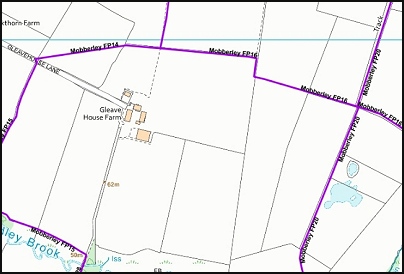 and do a little spelling correction (I don't think everyone uses a spell checker, in fact I'm certain they don't !!) and do a little spelling correction (I don't think everyone uses a spell checker, in fact I'm certain they don't !!)The compilation is then converted to HTML and placed on the KOS's website - click here. For those uncertain about their local public footpaths click on this link it takes you to the definitive map of all East Cheshire's paths. Zoom in to your own patch and there they are. Zooming in further reveals details of individual fields and small ponds. The example shown shows a small area around the Fox Harbour area of Mobberley, including the famous "magic pool"! When this is all over (how many times are we hearing this at the moment?) we'll assemble a list of all the species seen by observers who are presently covering this patchwork of small areas in their immediate locality without the use of motorised transport. It's a unique situation, hopefully not one we'll ever experience again but peoples' records shouldn't be lost. The last of our Winter friends have now left for the north and are being replaced by Summer visitors. So far correspondents have recorded - Chiffchaff, Sand Martin, Swallow, House Martin, Willow Warbler, Blackcap, Garden Warbler, Reed Warbler, Yellow Wagtail, White Wagtail, Little Ringed Plover, Osprey, Wheatear, Redstart, Common Sandpiper, Grasshopper Warbler and Reed Warbler. So we've plenty of the regulars to arrive and perhaps one or two surprises, like the White-tailed Eagle that was photographed yesterday overflying Macclesfield! The latest update from Burton Mere Wetlands, sent to me by Sheila Blamire, makes interesting reading. But who needs that lot when you've got your own little local patch - stay safe team, it'll be over soon!
05/04/2020...... Keeping in touch With group activities suspended and everyone confined to barracks for the foreseeable future, except for local periods of exercise in areas accessible without the use of a vehicle, we've been anxious that members keep in touch and some sort of continuity maintained. To that end, members (and any other interested parties) have been sending me, by email or text, brief accounts of what they've been up to during the "lockdown". It's working well and each evening I've been able to blend them into a daily summary and post it by email to all members and others who are on our "update" email list. I'm told they are proving to be both interesting and entertaining, and so, for the benefit of historians and infrequent or casual visitors to "ten-by-fifty-dot-com", I am putting the daily summaries onto a new webpage within the KOS website. You can read them by clicking here. Currently, from what limited data is available, Summer migrants are arriving on time with so far, Chiffchaff, Sand Martin, Blackcap and Willow warblers on time (and in a text from Darren Morris just received as I write! Swallow [Tatton]). Winter birds are hanging on with a few Redwings about, big flocks of Fieldfare passing through and a party of 30 to 50 Meadow Pipits this morning seen by Len Mason at Mobberley SQ. If you're spending a lot of time in the garden a good way to make your records count is to sign up for the BTO garden birdwatch scheme. It's now free for as long as the current crisis lasts - click here for details Birdwatchers are fond of their abbreviations, Common Sand, Great Spot are commonly heard with Gropper, Lesserpecker, Blackwit etc. less so and I even remember PGtips (anyone?) being used for one species! The term vismig short for visible migration is now in everyday use with nocmig (nocturnal migration) the new kid on the block! Every year around the beginning of October migrating Redwings can be heard at night passing over in large numbers, their high pitched "seeep" calls easy to pick out. But now nocmig enthusiasts are going one step beyond with all manner of expensive electronics and complex computer programs being used to identify and quantify overflying night-time species. Locally Hugh Pulsford alerted us to the overnight passage of Common Scoters, during the first few days of the month, as they moved en masse from their Irish Sea wintering quarters to breeding grounds in northern Europe (read about it here). I spent half an hour last night sat in the garden listening for them without success. It was a great night though, no traffic - air or road and a clear moonlit sky, ideal conditions but not a peep!! Suitably inspired, over in Merseyside, Barrie (The Lad) Armitt is giving the new technique a coat of looking at. Saw your reference to 'nocmig. Fascinating topic. Perfect for your good self: involves setting up some kit in the back garden and then sitting at a computer checking sound files and spectrograms captured whilst asleep. None of this walking around birding - comfort of sitting room with a coffee;-) and it involves squiggles on a monitor: your sort of thing. I've been looking into it since last year. Had a bird singing that I couldn't place so used my trusty Samsung S5 to record the song. Not a great recording but identifiable later. Made me look into better quality devices. There are better sound recording apps available for your phone and I've used one and it's an improvement but not up to 'nocmig' stuff. This year I've set about things a more seriously. Trektellen has a 'nocmig' section that's great. Some even post their records with a 'zeno canto' link so you can hear and see a spectrogram. All very interesting. It has prompted me to buy a decent recorder and download the software for creating and analysing the audio files. You'll be pleased to know yesterday I recorded my first fly-over and created my first spectrogram. A fitting species: Meadow Pipit lol. You also mentioned ducks recorded at night recently. This began around the 1st of April and involves a lot of Common Scoter. The birds I count off Formby ( 10,000+) are part of a huge wintering population (100,000+) off the coast in the Liverpool/Morecombe Bay area. They migrate east overland to the north sea at an average of 33 mph so a 3 hour flight (ish).... took me 10 days to walk it and 5 days on a bike :-)Thanks Baz let us know how you're progressing - and to you and everyone else - stay safe. 25/03/2020...... Making the most of it! Some people do their best to embrace the Winter; even the miserable, wet affair we're just emerging from. Others struggle to derive any satisfaction from the colder months but whatever their perspective, for all birders, it's Spring they look forward to the most, and for the past few days the weather has been perfect - sunshine and blue sky with the mercury today into the mid to upper teens. Normally reports are pouring in from Tatton, Rostherne, Marbury, Woolston etc. and it can be a big job untangling them all and distilling them 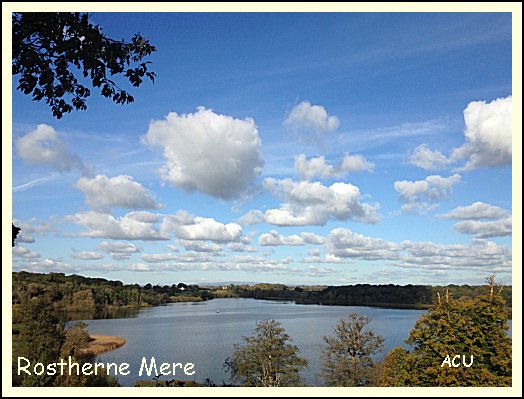 down for this bit of the website. Hard work sometimes but nevertheless most enjoyable. That's normally - this Spring's not normal. down for this bit of the website. Hard work sometimes but nevertheless most enjoyable. That's normally - this Spring's not normal.At the time of writing Tatton park, Rostherne Mere NNR, Woolston Eyes, all RSPB and WWT reserves are closed for the duration, even Goostrey's bakery in Mobberley has closed - no more sausage rolls - a measure of the seriousness of the situation . We are allowed out for exercise once a day, so I've been receiving some reports from our KOS members who've been out and about locally, making the most of the conditions whilst even these limited facilities are available to us. Before the drawbridges were raised the first Sand Martins had arrived. Jacquie Ledward was the first of our members to record them this year with 10+ over Budworth Mere last Wednesday (18th). Tatton's first came three days later (21st) when Darren Morris had a bird over the main mere as he cycled to work in the park, later in the day Bob Groom counted between 33 and 36 at the same location............. the Sand Martins were there in force, favouring mid-mere, rather than top end. No doubt the same birds that Darren had seen earlier. My counts ranged from 33 to 36 so I'll settle for 35, give or take. Lots of other good sightings, Kingfisher again at Melchett, 2 Grey Wagtails at the edge of the mere, not far from the deer fence, several Herons, Buzzards constantly in view. Bob's confining his activities to the area around Green Lane .... I have been up the lanes and had some nice sightings. Singing Chiffchaff I followed up Green Lane to the regular breeding place in the shrubbery of Moss Corner Cottage. 5 Buzzards up together. Several Lapwings displaying, 2+2 Stock Doves. I was just counting Fieldfares (had got up to 32) when the muck spreader swung into the field and I had to beat a hasty retreat (as did the fieldfares)! Jay, Kestrel, 2 Long-tailed Tits, lots of House Sparrows. It appears that we'll all be doing a lot of garden birdwatching this year! Here in Bucklow Avenue we're lucky compared to many people, we have small front gardens but they're much bigger at the back (ours is 70' long) and attract plenty of wildlife. The feeders are still busy with visiting Goldfinch, Blue, Great and Coal Tit's and the occasional Great Spotted Woodpecker. All three Tit species are in song, together with a Greenfinch which sallies forth from time to time from a neighbours conifer in it's fluttering display flight . At the bottom of the garden there's a mixed hedge of holly, hawthorn and hazel plus a nice silver birch and a 30' high ash tree. Below these, the wildlife pond I dug out last year - now with resident frogs and emerging tadpoles that seem to be co-existing with the four goldfish I introduced (against everyone's advice!) At the rear of the house we have timber decking that remains out of direct sunlight until about 2pm each day and I spend many hours relaxing there, binoculars at the ready, hoping for something different to pass over. Last year I had Red Kite, Osprey and numerous Hobby sightings. I suspect this time around I'll be spending a lot more time there!!We're living in challenging times but I'm sure binocs. will still be pointing skyward - from local lanes, gardens and even windows. Let me know how you're managing and what you're seeing so that this Spring that never was won't be wasted. The internet is proving to be a godsend during these difficult times and many a happy hour can be passed watching ornithological webcams. I'll mention now a selection of these - there are many more and if you have any favourites let me know and I'll share them on here. The Dfi Osprey cameras are excellent, pin-sharp HD images from a location we know so well. They are due to come online imminently Glaslyn Ospreys. The first bird has returned and the webcam is on. Another site we're familiar with. Gaslyn Ospreys - click here. Loch of the Lowes webcam - now online and again one of the pair is in situ.Loch of the Lowes webcam - click here Kittiwake webcam from Gateshead - turn the sound down, they're very noisy! Peregrine Falcon Webcam from Leamington as recommended by Phil Rowley (thanks Phil!) Leamington Peregrines -click here. Well that's about all for now team! Keep smiling, keep watching, keep in touch and stay safe!17/03/2020...... Well it's Spring but not as we know it! As they say in Mobberley - "This virus thing is a bit of a bugger!" It certainly is and it's very difficult to come to terms with - quite surrealistic and unbelievable. We Homo sapiens are just a very small part of the natural world and, apart from us, the rest (as far as I know) remain unaffected by the current problem. Just to prove the point, the first of our Summer migrants have returned and interestingly Chiffchaffs have appeared before Sand Martins, Tatton ranger Darren Morris and I both had what was probably the same singing bird in the park's Dog Wood On Sunday (15th) we travelled over to Pennington Flash and enjoyed what will probably be our last KOS field trip for some time. Even before we left the car park it was obvious that the water held plenty of wildfowl with Moorhen, Coot, Mute Swan, Mallard, Canada Goose, Tufted Duck and Goldeneye amongst the first species on our day list. Goldeneye were very numerous and when they took to the air later, Bob Groom (who took an alternative route around the flash) counted 50 birds. Two fine male Goosanders floated into view as we began our walk, whilst from the phragmites reeds the explosive song of a Cetti's Warbler, a species we heard a number of times as the morning progressed. Chiffchaffs were numerous but there was no sign of the Sand Martin that had been present for the previous few days. Hail to thee, blithe Spirit! Due to the ongoing Corona virus problem it's been decided that, with immediate effect, all KOS activities, both indoor and outdoor meetings will be suspended for the duration. All members have been informed. Along with everyone else we'll be keeping a low profile for the foreseeable future but I'll be hoping to do some birding away from others, including Fox Harbour in Mobberley, the quieter parts of Tatton and Rostherne where I'll be doing the breeding bird survey in Harper's Bank (an area closed to the public, even permit holders). I hope other members and correspondents will be able to get out safely and send me their thoughts and sightings for use in this part of the website.
Our small group of Knutsford birders has been going for 46 years now, meaning we've had about 320 evening presentations over the years and I've been to the vast majority - good, bad and indifferent! 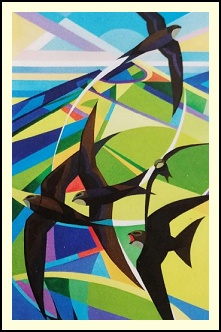 Last Friday's was exceptional and must rank in the top ten - Premier League stuff! Last Friday's was exceptional and must rank in the top ten - Premier League stuff!None of your birds-on-a-stick travelogues, this was real and practical ornithology as Tanya and Edmund Hoare introduced us the various organisations dedicated to the well-being of our Common swifts and their own efforts to try and halt the 56% decline in the population of the species over the past few years. The couple have a cottage in Cumbria, which hosts Swifts every Spring and when it needed re-roofing they arranged for the rubble between the joists to be removed, creating much needed extra space for the nesting birds. click here. Behind these spaces, on the inside of the bedroom and bathroom, hatches were constructed giving access to the nest chambers (although these are never opened during the breeding season); more than 20 video cameras have been installed allowing continuous monitoring of activity in the nests - from the moment the first birds arrive back in the Spring until the last youngster fledges in August - now 2Tb of data; that's approximately one trillion bytes!! Video footage from the cameras and a series of easy-to-follow graphics were used during the presentation, showing rarely seen activity such as "wing standing", fighting between resident and intruder birds and even the antics of the parasitic swift lousefly that live off the blood of the adults and young - ugh! "Swifts Local Network" (SLN) has been set up. This will enable the many UK-based individuals and small groups now working on Swift conservation initiatives to share experiences and ideas more easily. Tanya suggested that a Knutsford group would be a welcome addition to the network. The Q&A session at the end of the presentation lasted twenty minutes, an indication of the interest created by our guests! Last Wednesday's midweeker (26/2) was a long overdue visit to Woolston Eyes. It was wet, very wet! The approach road to the reserve, past the industrial units, is worse than ever and the water filled potholes have to be treated with great caution. The paths on the reserve itself were quite treacherous too, ankle deep in muddy water, and no wonder, when we learnt this week, that last month was the wettest February since records began and the fifth wettest of any calendar month in a series from 1862. This Friday (6th) it's the Cheshire and Wirral Ornithological Society's AGM which will be followed by a presentation by Dermot Smith - "Mersey Estuary's Birds". 7:45pm in St. Vincent's Church on Tatton Street.
It appears there may be a brief period of relatively dry weather for a couple of days, after the prolonged period of wet weather, as a seemingly relentless train of low pressure areas have arrived from the Atlantic. Luckily we have hides at Rostherne and Tatton, so we do have somewhere to shelter from the rain - although it must be said, there's not a lot about! The male Stonechat remains in the park and is often viewable from the Allen hide and near the car park Siskins and a substantial mixed flock of Chaffinches and Goldfinches are feeding in the Alder trees. The water level at Rostherne is very high; the path to Harper's Bank wood is submerged and a brown slick of suspended sand and soil, washing out of Rostherne Brook is spreading across the mere. Bob Groom and I visited the obs. yesterday (24th) when a group of workers were dealing with one of the big trees that were felled in the recent gales. Two people went into the rear door of the boathouse and as they did a Barn Owl exited through the front! It was no doubt roosting in there during the daylight hours. Also seen during the morning - Buzzard, Kestrel, Sparrowhawk and a Peregrine Falcon; a good day for predators! Some members have ventured further - Ken and Shirley Davies have been on the road again in the camper, this time down to Slimbridge. Ken and Shirley's motor home travels.
Dave and Izzie Butterworth travelled even further south, well past Stoke, and enjoyed a holiday in Uganda! They have kindly provided me with an account of their adventure. It's quite large so has been given the honour of a page of it's own! CLICK HERE - http://www.10x50.com/uganda.htmPreparations are going ahead for our long weekend on the Isle of Anglesey in early June. At the moment nine members have signed up, with more to follow, depending on circumstances. Our next KOS indoor meeting is this Friday (28th) when Tanya Hoare will be telling us all about "Our not so Common Swifts" See you there - same time, same place.
14/02/2020...... Tatton and the Wirral Saturday the 8th and a good turnout of members for the February field trip around Tatton Park, ahead of approaching storm Ciara that was to cause so much damage 24 hours later throughout the UK. We followed the usual route - from the Dog Lodge layby, across Knutsford Moor, entering the park via the main gate before walking alongside Tatton Mere as far as the Allen hide and returning to the cars via Dog Wood.We're still waiting for singing Cetti's Warbler on the Moor, it can't be long now! So for the time being we had to be content with a Reed Bunting in song from deep inside the phragmites, whilst on the water of the "back pool" Great Crested Grebes, Tufted Ducks and a returning Gadwall. In the woodland immediately before entering the main gates we enjoyed good views of a Treecreeper and the songs of Song Thrush, Stock Dove and numerous Coal Tits, all encouraged by the bright sunshine and reasonably mild weather, unaware of the challenges that lay ahead the following day as Ciara arrived.Tufted Ducks, displaying Goldeneye and a flock of 17 Pochard populated the southern end of Tatton Mere, whilst in the tall trees of Higmere Plantation, overhanging the mere, Grey Herons had returned to their nests; difficult to see silhouetted against the sun at this time of the morning but later views, on our return through Dog Wood, revealed that some appeared to be on eggs already. The early bird catches the worm - but also catches the winter wind and they would have done well to survive the oncoming storm. We met up with Bob Groom who was already ensconced in the Allen hide and was able to add Green Woodpecker, Mistle Thrush and Lapwing to a reasonable final tally of 43 species which was quite satisfactory given the time of year. Unfortunately the wintering Stonechats didn't put in an appearance; perhaps they've joined their vagrant cousin over at Ashton's flash in Northwich! For those that don't enjoy the winter weather - and, strange as it may seem, there are some - a reminder that the average date for the return of the first Sand Martin of the year over Tatton Mere is the 14th of March - only a month to go!
The coffee in the reception building was well up to standard and I noted that if you take your own cup it's 20p off and even better value at £ 1:60! A few Little Egrets have returned but for the time being they were outnumbered by Great White Egrets with seven on the reserve and no less than 11 the previous day! The Inner Marsh hide was very busy and seemingly populated by what have been described elsewhere as "Hybrid" birders, all camera and no binoculars! Here a couple of Pintail were added to the day list, along with two Knot, the first I've ever seen on the reserve. Making my way back I met up with Frank and Len returning from the steep hill just beyond the edge of the reserve, from the top of which you get wide-ranging views across the estuary. Well no! don't get confused here - they'd been looking at it - not climbing it! There's a sheltered little spot on the return route and here, out of the wind, Blackbirds fed, a Goldcrest also busily collected food and a flock of Long-tailed Tits hawked for winter gnats, tiny pin pricks of light, visible only because of the low winter back light highlighting them and shining through the wing and tail feathers of the Tits making them appear semi-transparent. A wonderful photo opportunity missed by the photographers as they trundled off to Parkgate.Predictably the car park at the old baths was full and so we parked a short distance away in a location I'd ear-marked on a previous visit, ready for such an occasion. The old baths were choc-a-block as we arrived, crowded with birders waiting expectantly for the high tide which was due at 1:20pm. The previous day the tide was so high that the baths and car park were flooded but no such luck today as 1:20pm came and went. Nevertheless there was plenty of activity and a Kestrel, three Marsh Harriers and a nice male Hen Harrier was added to our list. Others also reported Short-eared Owl, Merlin and Peregrine. Anxious to escape from the cold wind blowing across the estuary Len Mason scanned the fields behind the baths and reported Redwing, Song Thrush, Skylark and a flock of Linnets - quite like the old days. The tide did hold up and may even have risen further but by then we were viewing it through the windows of the Parkgate chippie!
This year I've invested in a Tatton Park entry/parking permit, through the good offices of the Tatton Garden Society; it's cheaper than applying directly to Tatton and members receive a discount at some of the local garden centres. Consequently I'm able to park at the far end of the main mere and enjoy the peace and quiet of the Allen hide, overlooking Melchett Mere, more often - this is not the most productive spot in the park for the birdwatcher, that's still Dog Wood and Knutsford Moor but it does provide welcome shelter during the wet winter months that seem to be the norm nowadays in this part of the world. Today (6th) Bill Killey and I paid a visit to Shipbrook Hill Farm, Whatcroft and did a short bird survey on behalf of the owner Simon Bennett. The survey is organised by the Game and Wildlife Conservation Trust and known as the "Big Farmland Bird Count". Last year 1,400 farmers took part and recorded 140 species across more that a million acres.
27/01/2020...... A busy weekend! A busy weekend for the KOS began on Friday evening (24th) when we welcomed back Keith Offord who entertained us with his talk "Land of Contrasts - Namibia", as usual Keith produced an excellent lecture, which was enjoyed by an appreciative audience of 28 members, including two newcomers, Liz and Martin Attwood - welcome aboard folks! On Saturday and Sunday we joined forces with "The Friends of Knutsford Moor" (25th) and "The Friends of Knutsford Heath" (26th) for their annual RSPB Big Garden Birdwatches.
The Heath covers about the same area as the Moor but the latter benefits from large areas of reedbeds and associated stretches of open water, so the Heath will always be the poor relation species-wise. Nevertheless it came close this year with 20 recorded, one up on 2019 and the organisers were pleased to see the resident species doing so well, especially the count of 11 Long-tailed Tits, the highest yet. Redwing was an all-time new bird and a handsome Buzzard perched in the woodland posed well for our party. Our thanks go to the Friends of both areas for inviting us along and to the KOS members who turned out to help - most enjoyable!
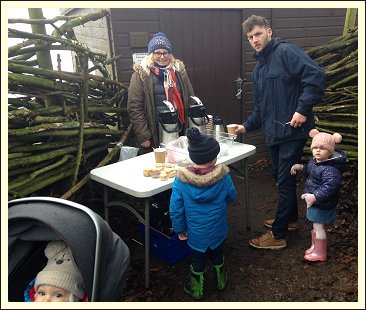 It was certainly cold enough, the car was frozen over at 8am and the temperature never rose above 3
°
C during the morning but unfortunately there was a thick mist that made viewing from the hide a bit challenging.
Fortunately this didn't put off visitors to the park, the Knutsford Drive was busy with walkers, cyclists and motorists and we had no difficulty in enticing a steady stream of visitors into the hide, a task made so much easier with the promise of free tea, coffee and biscuits supplied by Yvonne and Darren! We had to keep checking that the hide wasn't getting too It was certainly cold enough, the car was frozen over at 8am and the temperature never rose above 3
°
C during the morning but unfortunately there was a thick mist that made viewing from the hide a bit challenging.
Fortunately this didn't put off visitors to the park, the Knutsford Drive was busy with walkers, cyclists and motorists and we had no difficulty in enticing a steady stream of visitors into the hide, a task made so much easier with the promise of free tea, coffee and biscuits supplied by Yvonne and Darren! We had to keep checking that the hide wasn't getting too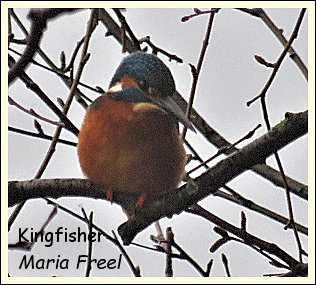 busy and tried to regulate the numbers, so as not to overwhelm the KOS members inside who were dealing with the public, but at one stage Derek and I couldn't resist inviting a walking group of 16 down to the hide!
This year I tried to keep a count of visitors on my trusty dictaphone, I know I missed loads but when I played it back later I'd recorded 73 visitors, so that was the minimum and the true total this year was probably approaching 100.
As well as the refreshments we were able to (almost) promise real-life views of an obliging Kingfisher that was in situ when our Hon. Chairperson arrived, during the morning the bird would leave for a few minutes before returning to one of it's favourite perches, a number of visitors were profuse with their thanks as they left "We've seen them on TV but never in the wild!".
A nice busy and tried to regulate the numbers, so as not to overwhelm the KOS members inside who were dealing with the public, but at one stage Derek and I couldn't resist inviting a walking group of 16 down to the hide!
This year I tried to keep a count of visitors on my trusty dictaphone, I know I missed loads but when I played it back later I'd recorded 73 visitors, so that was the minimum and the true total this year was probably approaching 100.
As well as the refreshments we were able to (almost) promise real-life views of an obliging Kingfisher that was in situ when our Hon. Chairperson arrived, during the morning the bird would leave for a few minutes before returning to one of it's favourite perches, a number of visitors were profuse with their thanks as they left "We've seen them on TV but never in the wild!".
A nice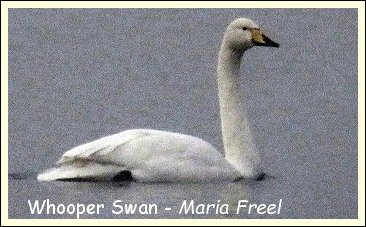 enough bird but from our point of view the star of the show was a lone Whooper Swan that appeared through the mist shortly after we'd heard it calling as it approached the mere. A few lucky people were able to see it in the 'scopes before it vanished across the far side never to be seen again - during out two hour session anyway!
We managed a modest total of 22 species, which wasn't bad under the circumstances but the morning is really about enhancing Tatton's visitor experience, introducing people to the Allen hide and perhaps raising our KOS profile. We handed out plenty of our "business cards" and amongst Sunday's visitors were regular readers of this website and it was great to be able to put faces to a few names!
Thanks go to all the KOS members who turned up to help, especially Yvonne and Darren for providing and serving the refreshments.
Another busy weekend coming up.
On Friday (24th) it's our January indoor meeting in the Jubilee Hall when Keith Offord will be talking about - "Land of Contrasts - Namibia".
The following day (Saturday 25th) we'll be helping the Friends of Knutsford Moor with the RSPB's Big Garden Birdwatch. 11am until noon. Meeting in the Moor shelter at 10:45am
On Sunday (26th) it's repeat exercise with the Friends of Knutsford Heath. again 11am until noon, meeting at 10:45 close to the junction of Stanley Road and Northwich Road. enough bird but from our point of view the star of the show was a lone Whooper Swan that appeared through the mist shortly after we'd heard it calling as it approached the mere. A few lucky people were able to see it in the 'scopes before it vanished across the far side never to be seen again - during out two hour session anyway!
We managed a modest total of 22 species, which wasn't bad under the circumstances but the morning is really about enhancing Tatton's visitor experience, introducing people to the Allen hide and perhaps raising our KOS profile. We handed out plenty of our "business cards" and amongst Sunday's visitors were regular readers of this website and it was great to be able to put faces to a few names!
Thanks go to all the KOS members who turned up to help, especially Yvonne and Darren for providing and serving the refreshments.
Another busy weekend coming up.
On Friday (24th) it's our January indoor meeting in the Jubilee Hall when Keith Offord will be talking about - "Land of Contrasts - Namibia".
The following day (Saturday 25th) we'll be helping the Friends of Knutsford Moor with the RSPB's Big Garden Birdwatch. 11am until noon. Meeting in the Moor shelter at 10:45am
On Sunday (26th) it's repeat exercise with the Friends of Knutsford Heath. again 11am until noon, meeting at 10:45 close to the junction of Stanley Road and Northwich Road.
13/01/2020......The first field trip of the new decade!
At least three KOS members succumbed to temptation and travelled over to take a look at this rare vagrant. Bob Groom was suitably rewarded for his persistence - Went over to the flashes this morning. I had a quick look at Neumann's then spent 2 hours, with other birders, looking in vain for the bird from the bund bench. I did see Green Woodpecker, Shovelers and Skylark. I was getting ready to leave as I had an afternoon meeting when the news came through that it had been located. It was a scramble through briars and branches but I made it and caught up with the rest. Really good, close views. What a little stunner it is, great to see. The first signs of the coming breeding season locally with The Hon. Sec. reporting Rooks in attendance and nest refurbishment underway at the small rookery next to the M6 services (31/12) and Buzzards displaying over the new building site (190) houses opposite the entrance to Lilac Avenue(10/1). Through the window of the Parkgate chippy we watched Marsh Harriers hunting over the reeds, a bit of a challenge for them as they struggled against the ever increasing south-westerly wind. Nothing new from our next port of call, the Old Baths, so we walked along the old quayside as far as Cottage Lane, the estuary on one side and the Heswall golf course on the other. Redwings fed on the field behind the baths, other new species en route included Pied Wagtail and Meadow Pipit - not rarities of course but welcome additions to the list. Highlight was a distant male Hen Harrier, a species we'd hoped to see, not good views but they all count! Returning to the Baths we met up with Bob and Len who'd been lucky enough to see a great White Egret and a Merlin, bringing the final tally to 57 species. It's worth noting that winter counts are often greater than we manage during the spring and summer! Don't forget that on Sunday (19th) it's our Winter Wildfowl Watch in Tatton Park at the Allen hide overlooking Melchett Mere from 11:00am until 1:00pm. This has become an annual event, in conjunction with the Park rangers and all are welcome - Darren the Ranger and Yvonne will be providing tea and coffee, for us and any members of the public who feel inclined to join us in the hide!
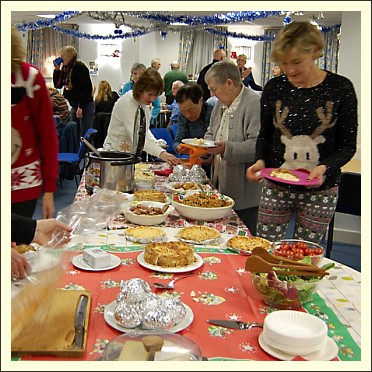 13,000; I couldn't find anyone with less than our 38 members! So a turnout of 27 for the Christmas party on Friday, representing 71% of the total membership was very encouraging. It was a most successful evening, the buffet was exceptional this year with members providing, mostly homemade, food - ranging from my simple jacket potatoes to complex examples of culinary art - meat and vegetarian chilli, creme brulee and a delicious pavlova that vanished so fast the usual suspects were denied a second helping! The Hon. sec. kept the evening on track and, in his own inimitable manner, managed to squeeze a few more quid out of members during the final auction. Len Mason won the quiz this year, mainly due to his knowledge of the topography of our Cheshire meres and the following day, Hon. Treasurer Frank told us that we made a record profit of
£400. Well done everyone - a great team effort that will keep us in speakers for another 12 months! 13,000; I couldn't find anyone with less than our 38 members! So a turnout of 27 for the Christmas party on Friday, representing 71% of the total membership was very encouraging. It was a most successful evening, the buffet was exceptional this year with members providing, mostly homemade, food - ranging from my simple jacket potatoes to complex examples of culinary art - meat and vegetarian chilli, creme brulee and a delicious pavlova that vanished so fast the usual suspects were denied a second helping! The Hon. sec. kept the evening on track and, in his own inimitable manner, managed to squeeze a few more quid out of members during the final auction. Len Mason won the quiz this year, mainly due to his knowledge of the topography of our Cheshire meres and the following day, Hon. Treasurer Frank told us that we made a record profit of
£400. Well done everyone - a great team effort that will keep us in speakers for another 12 months!Predictably, fewer people met up on a cold and drizzly Sunday morning (15th) for our December field trip up to Marshside and Martin Mere. Just 4
°
C as we arrived at Marshside, although the rain had stopped and overnight snow on the distant Pennine hills provided a beautiful Winter backdrop, against which the silhouettes of flocks of Pink-footed Geese were a fine sight as they passed out towards the Ribble estuary. The admission price for adult non-members at Martin mere is now
£
13.00 and a still a hefty
£
11.04 for concessionary entry - I think they're pushing their luck a little with those prices, especially as the area of pens containing the collection of wildfowl from various parts of the world seems to have been neglected over recent times and isn't a patch on what it was in the past. On Monday 30th December we'll be doing what is now our traditional post-Christmas walk around the Northwich Woodlands (Neumann's, Haydn Pool, Budworth Mere etc.) meeting at 10:00am at the usual Witton Bridge car park. So, to all KOS members and any others who happen to pass this way - have a happy and peaceful Christmas and, if we don't see you on the Christmas walk, best wishes for a happy and healthy new year.
|


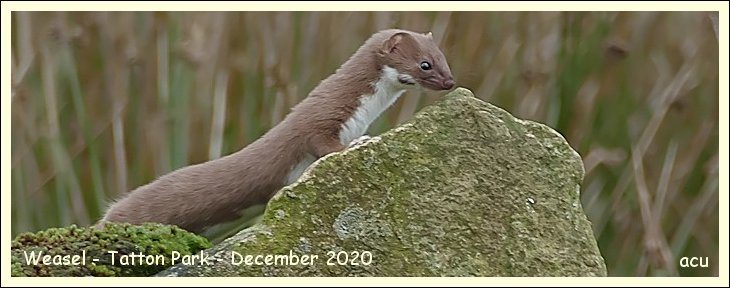

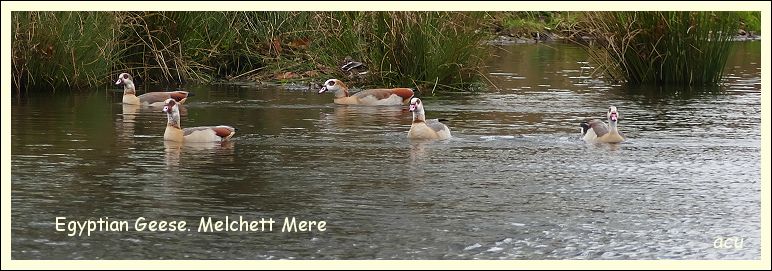
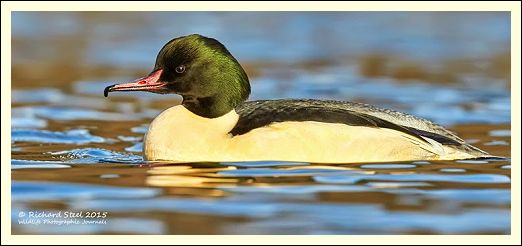 poured into the Coward Reedbed. Suddenly the Sparrowhawk swooped down and grabbed a poor unsuspecting Starling. You could hear it's cries as it flew off with its bounty. The starlings chattered noisily and I waited a while determined to try and see the Bittern (Ruby had seen it twice last week). I was not disappointed as the Bittern flew right across the reedbed and landed in the middle of the Starlings no doubt to feast on the poor creatures.
poured into the Coward Reedbed. Suddenly the Sparrowhawk swooped down and grabbed a poor unsuspecting Starling. You could hear it's cries as it flew off with its bounty. The starlings chattered noisily and I waited a while determined to try and see the Bittern (Ruby had seen it twice last week). I was not disappointed as the Bittern flew right across the reedbed and landed in the middle of the Starlings no doubt to feast on the poor creatures.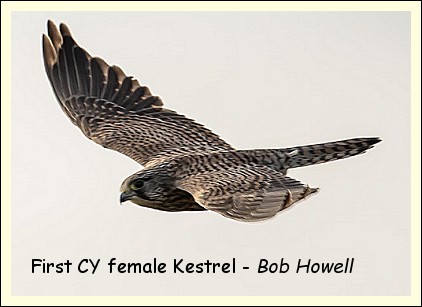
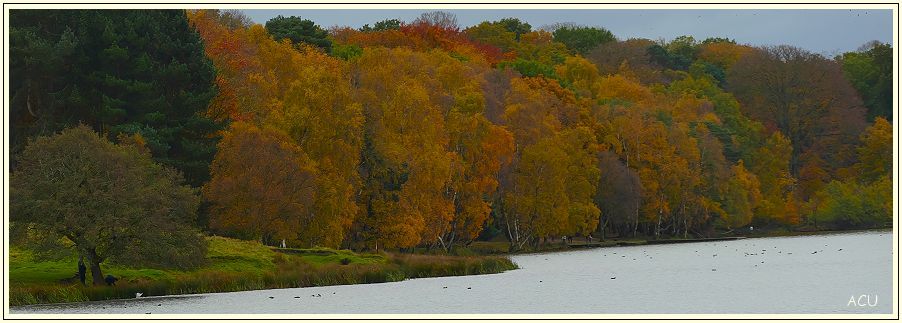
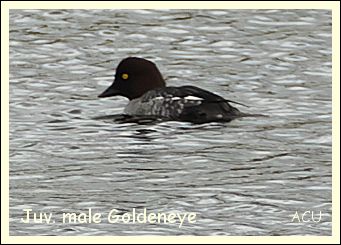 Bob Groom was in the park earlier today (5th), enjoying the current dry spell...... Had a couple of hours in Tatton today but it was a grey day so less activity than Tony and David had. Buzzard on the usual dead tree, Cormorants, Little Grebe. Single drake Pochard on Melchett but 7 males and 2 females on Tatton Mere, where also a young drake Goldeneye coming into full plumage and 4 what by now I can call females. At Melchett a menacing Heron and ear-twitching red deer put up a Snipe. Another (or same) was put up by walkers.
Bob Groom was in the park earlier today (5th), enjoying the current dry spell...... Had a couple of hours in Tatton today but it was a grey day so less activity than Tony and David had. Buzzard on the usual dead tree, Cormorants, Little Grebe. Single drake Pochard on Melchett but 7 males and 2 females on Tatton Mere, where also a young drake Goldeneye coming into full plumage and 4 what by now I can call females. At Melchett a menacing Heron and ear-twitching red deer put up a Snipe. Another (or same) was put up by walkers.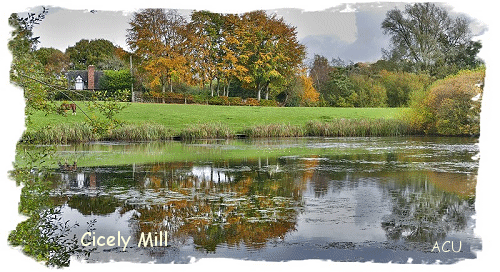
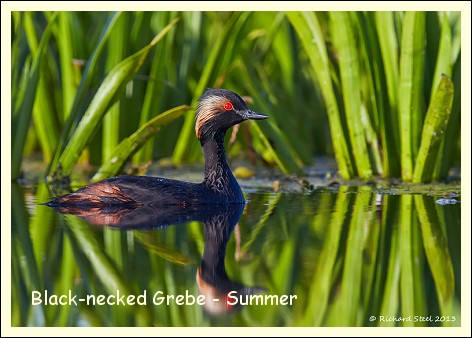 Heath seen by Derek Pike. Redwings are now widespread and being seen throughout the area but the brief Summer / Winter overlap seems to have passed with the final Swallow of the year seen by Bob groom flying south over Tabley yesterday (17th) .
Heath seen by Derek Pike. Redwings are now widespread and being seen throughout the area but the brief Summer / Winter overlap seems to have passed with the final Swallow of the year seen by Bob groom flying south over Tabley yesterday (17th) .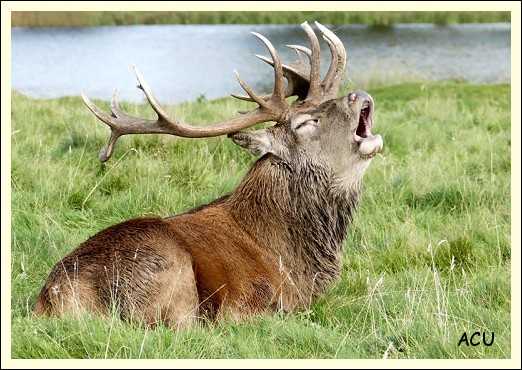 Having caught up with the news we ploughed on.
Having caught up with the news we ploughed on.
 remained with us - Derek had a single bird over Lilac Avenue (25/9), Geoff and Sheila Blamire watched five over Cicely Mill on the 27th and Bob Groom had eight the following day at the same location. Later in the day Bob was delighted to find two Chiffchaffs in his small Queensway garden, feeding on Holly and Rowan berries.
remained with us - Derek had a single bird over Lilac Avenue (25/9), Geoff and Sheila Blamire watched five over Cicely Mill on the 27th and Bob Groom had eight the following day at the same location. Later in the day Bob was delighted to find two Chiffchaffs in his small Queensway garden, feeding on Holly and Rowan berries.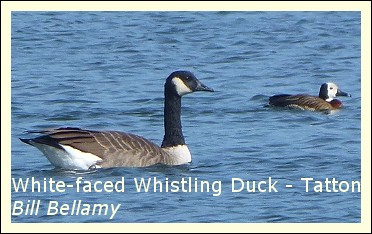 flying west over Tatton at 5pm this evening and earlier in the day as a Grey Heron landed in the reeds at Tatton's Melchett mere it flushed a Jack Snipe.
flying west over Tatton at 5pm this evening and earlier in the day as a Grey Heron landed in the reeds at Tatton's Melchett mere it flushed a Jack Snipe.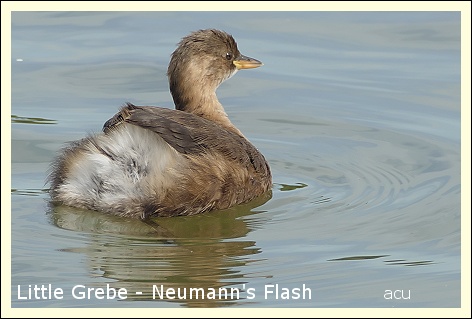 overflying our part of the world in October as they make their way over to the east coast for the Winter.
overflying our part of the world in October as they make their way over to the east coast for the Winter.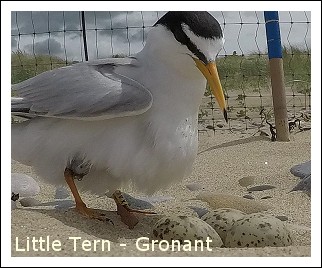 When I fitted geo locators to 15 of the incubating adults last year, this happened to be one of them and the attached image shows her at her 2019 nest, cropped from a Go Pro nest camera placed near the nest. You can just about see the device on the tibia (above the "knee") on her right leg.
When I fitted geo locators to 15 of the incubating adults last year, this happened to be one of them and the attached image shows her at her 2019 nest, cropped from a Go Pro nest camera placed near the nest. You can just about see the device on the tibia (above the "knee") on her right leg.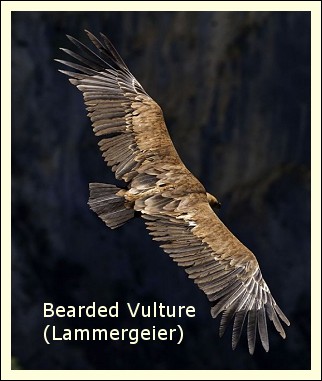 Soon into the walk we encountered numerous enthusiastic birders with 'scopes aplenty and we were lucky enough to have a sighting of the bird, sheltering from the rain, perched on a distant craggy.
Soon into the walk we encountered numerous enthusiastic birders with 'scopes aplenty and we were lucky enough to have a sighting of the bird, sheltering from the rain, perched on a distant craggy.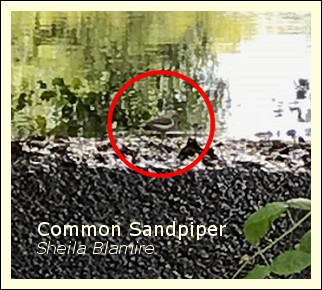 location where they are thought to have nested last year and the birds at Bob Groom's site, near Knutsford, have not yet dispersed having been watched by Geoff and Sheila Blamire on one of their recent morning workouts.
location where they are thought to have nested last year and the birds at Bob Groom's site, near Knutsford, have not yet dispersed having been watched by Geoff and Sheila Blamire on one of their recent morning workouts.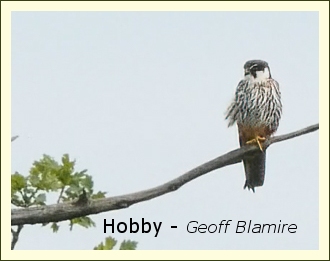 The birds were there in front of the hide - Whitethroats, Blackcaps and Reed Buntings plus my first Common Sandpiper this year feeding on the muddy water margins. So I was quite optimistic as I switched the camera to the on position, only to be greeted by the on-screen message "No SD Card". Oh dear - or words to that effect! I'd left it in my PC after yesterday's excitement (see below).
The birds were there in front of the hide - Whitethroats, Blackcaps and Reed Buntings plus my first Common Sandpiper this year feeding on the muddy water margins. So I was quite optimistic as I switched the camera to the on position, only to be greeted by the on-screen message "No SD Card". Oh dear - or words to that effect! I'd left it in my PC after yesterday's excitement (see below).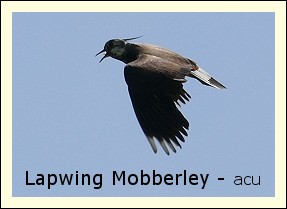 ringing process Buzzard and Hobby, with a Sparrowhawk later in the back garden.
ringing process Buzzard and Hobby, with a Sparrowhawk later in the back garden.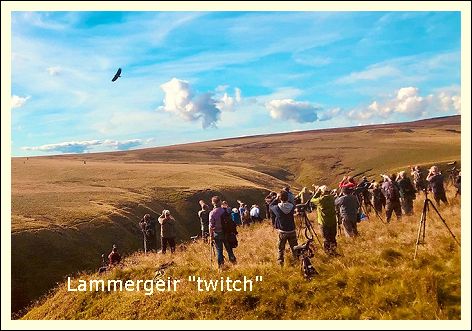 What luck!
What luck! 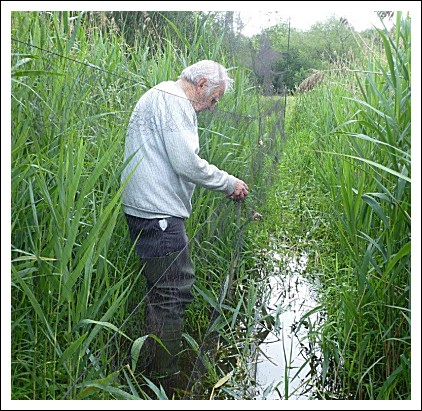
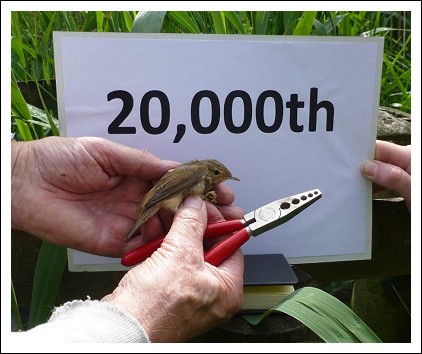
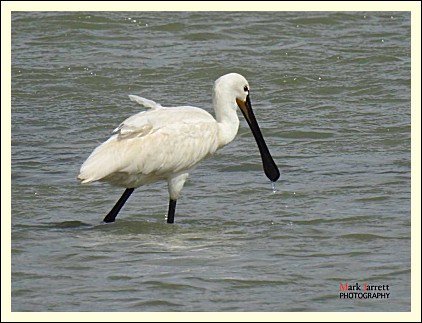 I was advised that the Spoonbill was there but asleep but when I got to Pod's hide it was busy feeding and gave great views right through the morning. Later it flew across to the sandy area to the right where it preened, standing seemingly as tall as a nearby Heron (one of three). Ken Davies joined me in the hide and we stayed undercover during the prolonged heavy rain (not forecast) as others came and went. A Little Egret gave good views, as did the sole Avocet. There were 2 Redshanks, 2 Little Ringed Plovers and 4 Pied Wagtails (3 of them juveniles). Pair of Shelducks had 8 young with them. A dozen Gadwall flew off. Little Grebe with 2 sizes of young. 3 Swifts, 2 Swallows and half-a-dozen House Martins. Buzzard the only raptor. Cuckoo heard. Saw a tiny young Water Rail (all black with a white beak) briefly before it scuttled back into the reeds. Another birder had seen 3 together on the path down! Walking back a Green Woodpecker flew across and a Great Spotted Woodpecker called from a little bare tree.
I was advised that the Spoonbill was there but asleep but when I got to Pod's hide it was busy feeding and gave great views right through the morning. Later it flew across to the sandy area to the right where it preened, standing seemingly as tall as a nearby Heron (one of three). Ken Davies joined me in the hide and we stayed undercover during the prolonged heavy rain (not forecast) as others came and went. A Little Egret gave good views, as did the sole Avocet. There were 2 Redshanks, 2 Little Ringed Plovers and 4 Pied Wagtails (3 of them juveniles). Pair of Shelducks had 8 young with them. A dozen Gadwall flew off. Little Grebe with 2 sizes of young. 3 Swifts, 2 Swallows and half-a-dozen House Martins. Buzzard the only raptor. Cuckoo heard. Saw a tiny young Water Rail (all black with a white beak) briefly before it scuttled back into the reeds. Another birder had seen 3 together on the path down! Walking back a Green Woodpecker flew across and a Great Spotted Woodpecker called from a little bare tree. 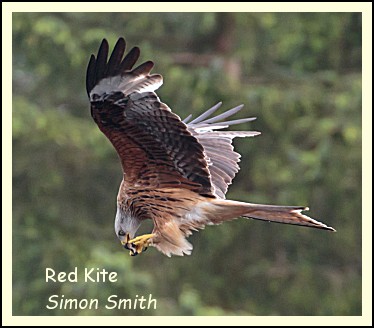
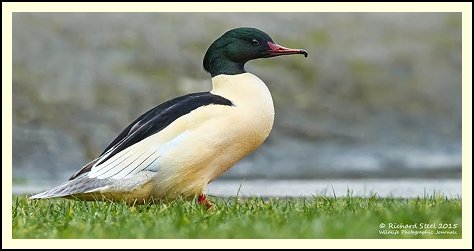 on the afternoon of Friday 13th. I was talking (at a safe distance!) to a group of Manchester birders this morning and they'd heard four or five at the same location earlier and reported a probable Blackcap in song. There was a singing Chiffchaff earlier from the Rostherne obs. (probably the first of the year) but no Sand Martins there either. It was a beautiful morning, crystal clear and through the big grey binoculars, set to 40X I could see people walking up Rivington Pike - a distance of 22 miles!
on the afternoon of Friday 13th. I was talking (at a safe distance!) to a group of Manchester birders this morning and they'd heard four or five at the same location earlier and reported a probable Blackcap in song. There was a singing Chiffchaff earlier from the Rostherne obs. (probably the first of the year) but no Sand Martins there either. It was a beautiful morning, crystal clear and through the big grey binoculars, set to 40X I could see people walking up Rivington Pike - a distance of 22 miles!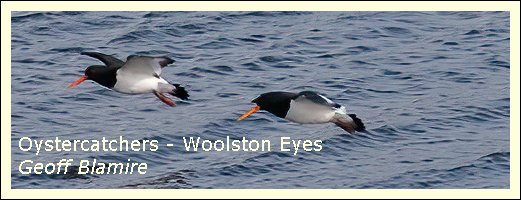
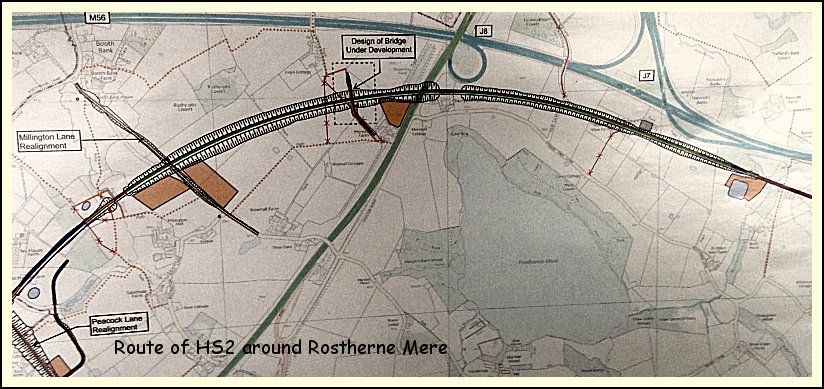
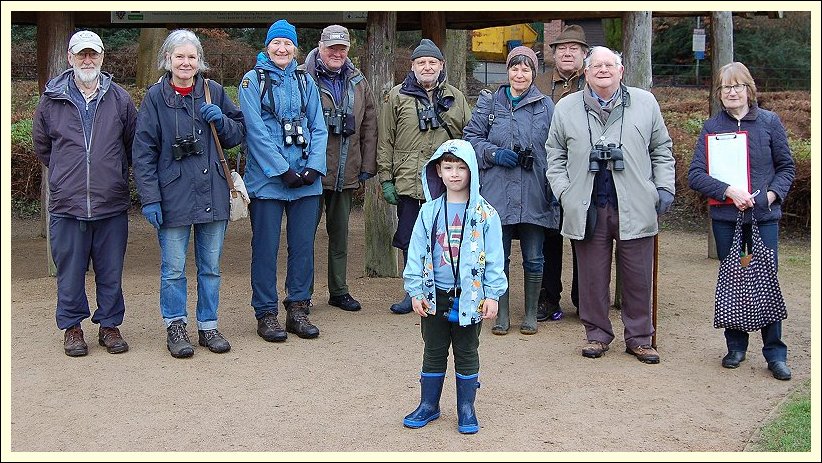
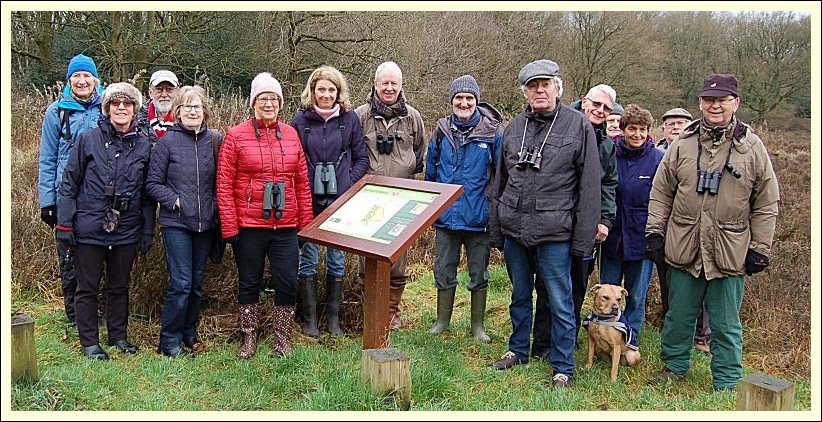
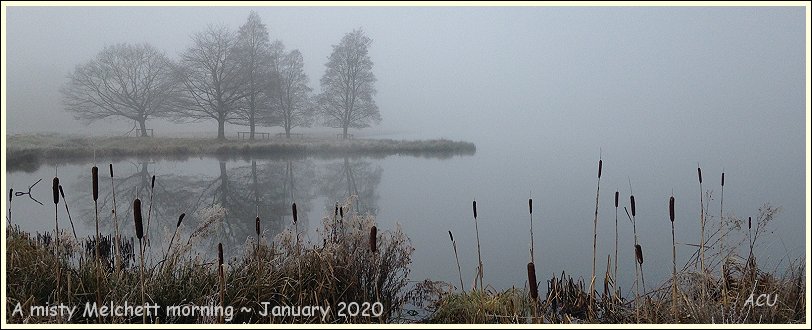
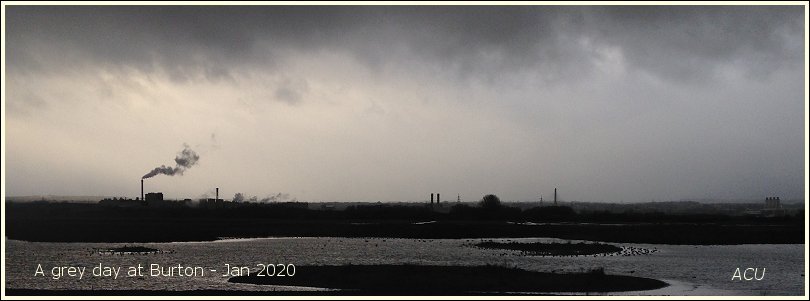

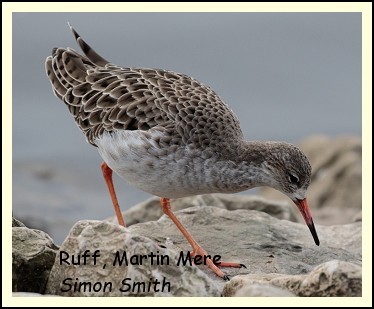 although there were fewer about this time - just a single Kestrel and a quite magnificent male Hen Harrier that was quartering the marsh as we made our way to the other hides. From Nel's hide we had good views of the usual Teal, Tufted Ducks, Shoveler, Pintail and Black-tailed Godwits plus thousands of Wigeon, the most numerous of the wildfowl species this year. There were only a few Curlew present this time around, a species that seems to be struggling more than most and a cause of great concern amongst naturalists.
although there were fewer about this time - just a single Kestrel and a quite magnificent male Hen Harrier that was quartering the marsh as we made our way to the other hides. From Nel's hide we had good views of the usual Teal, Tufted Ducks, Shoveler, Pintail and Black-tailed Godwits plus thousands of Wigeon, the most numerous of the wildfowl species this year. There were only a few Curlew present this time around, a species that seems to be struggling more than most and a cause of great concern amongst naturalists.